Eastern Europe and Scandinavia
23 April to 21 May 2017
23 April to 21 May 2017
photos by G.P. Jones using Nikon Coolpix L830 digital
camera, except where noted
Itinerary
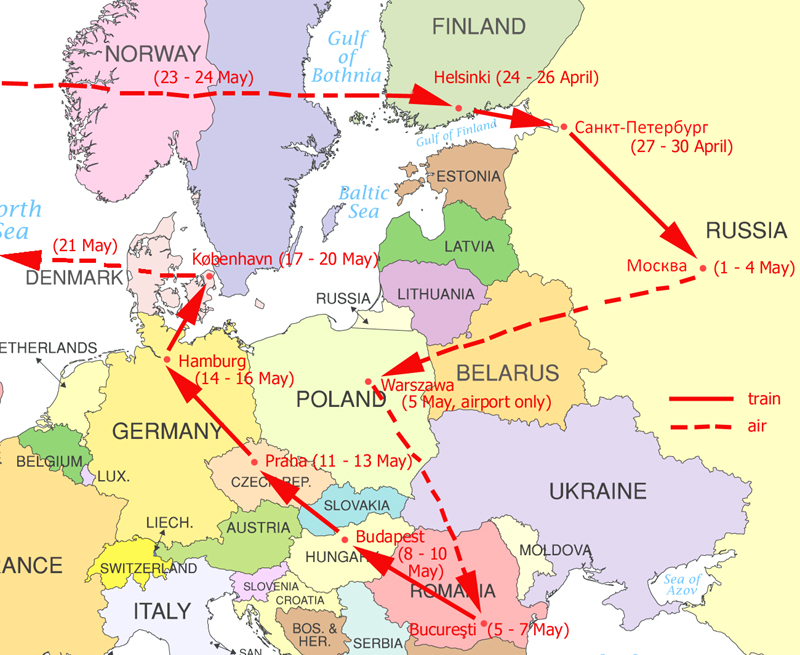
Helsinki, 24-26 April 2017

Senate Square, Helsinki. A main reason for visiting Helsinki was to gather information on the sculptor who is primarily responsible for the bronze parts of this monument, Walter Magnus Runeberg (1838-1920). This monument was constructed between 1894 and 1899, and is dedicated to Tsar Alexander II, the ruler when Finland was part of Russia. That's him at the top, holding up some pigeons.
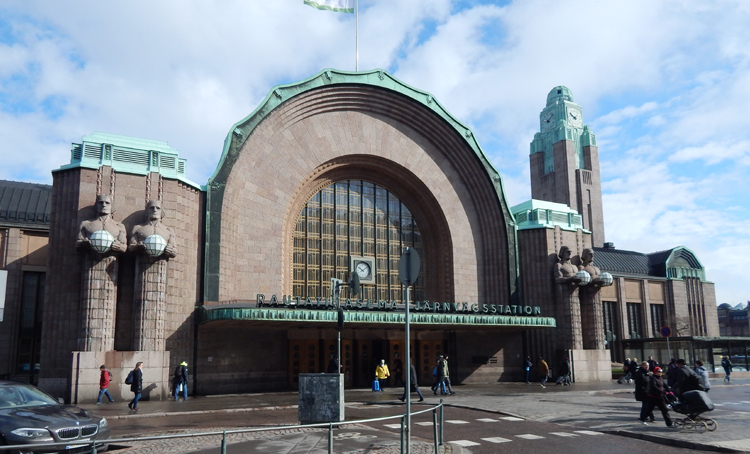
The Helsinki Railway Station looks Art Deco to me, but may not be, as it was designed by Eliel Saarinen (1873-1950) and inaugurated in 1919, six years before Art Deco was officially introduced to the world at the Paris Exposition in 1925. (But who's counting?)
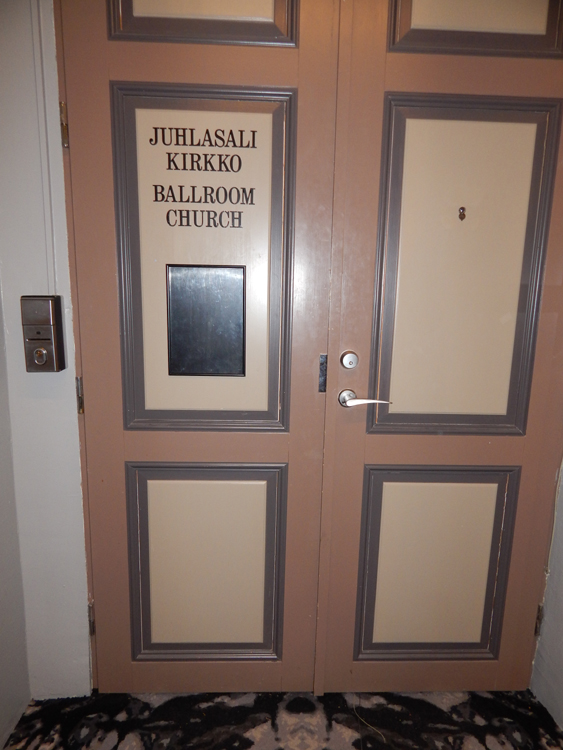
My hotel in Helsinki was an active prison until 2002. The Katajanokka still has features of its former life, including solitary confinement cells next to the restaurant in the basement. These days, unlike pre-2002 I'm told, it now has plumbing in the rooms making bucket-transfers unnecessary. (I'm not making this up.) I don't know if the combination Ballroom/Church was a remnant of the prison, but it just looks silly to me.
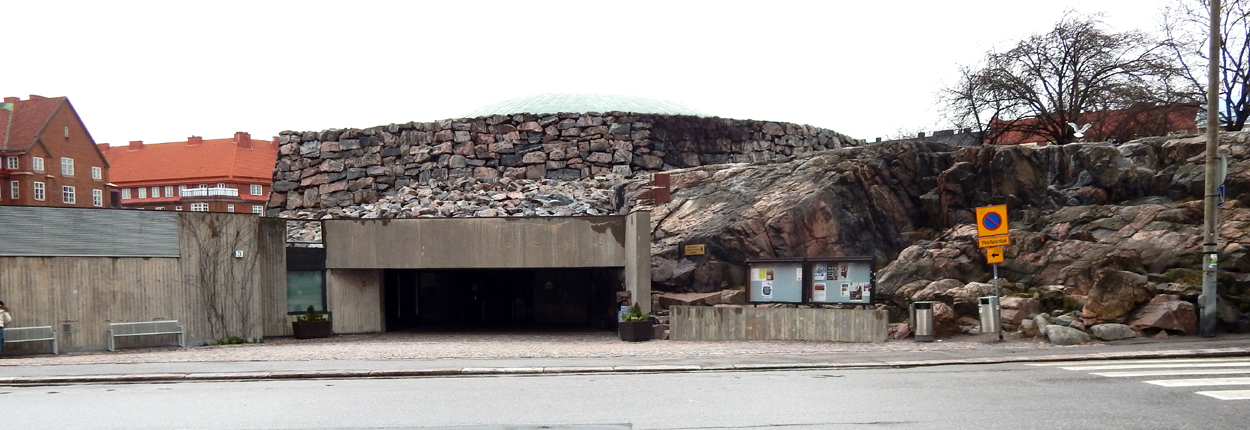
In the 1930s there was a competition for the design of a new church to be built in - not near, but in - one of the rock formations that are common in Helsinki. The war intervened, then the church was built in 1969. The result is the interesting Temppeliaukion kirkko, or Rock Church.
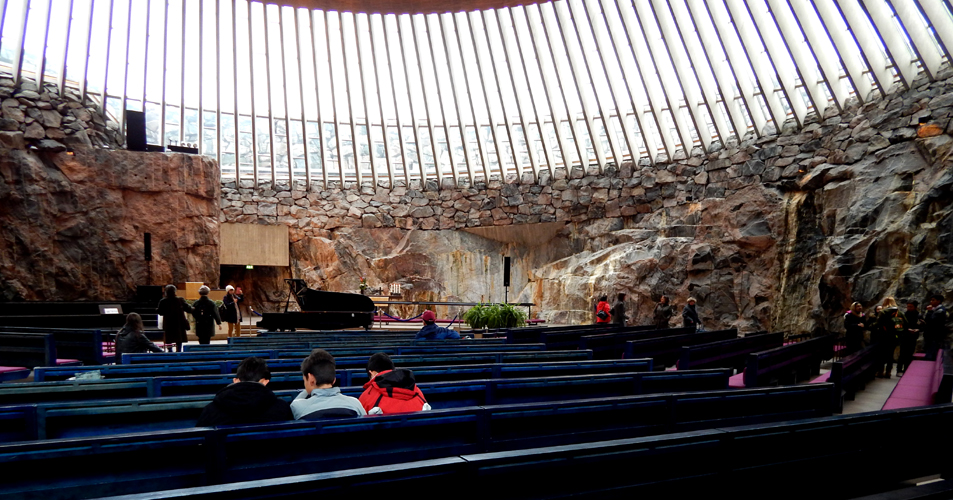
Like many Finnish churches, it's Lutheran.
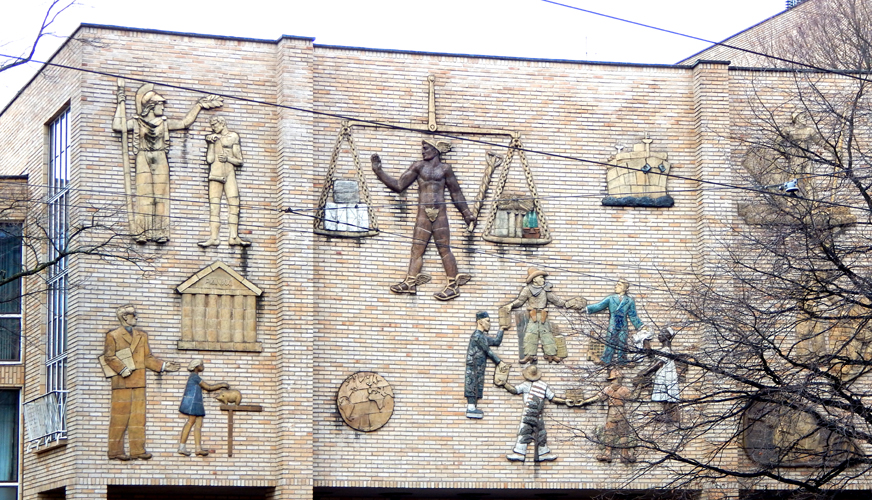
The façade of this building caught my eye, then made me laugh. The figleaf on the central figure of Mercury just looks prudishly ludicrous. If the artist (or sponsors?) were so concerned, why didn't they just put Bermuda shorts on him? Then they could claim his sandals were Air Jordans.
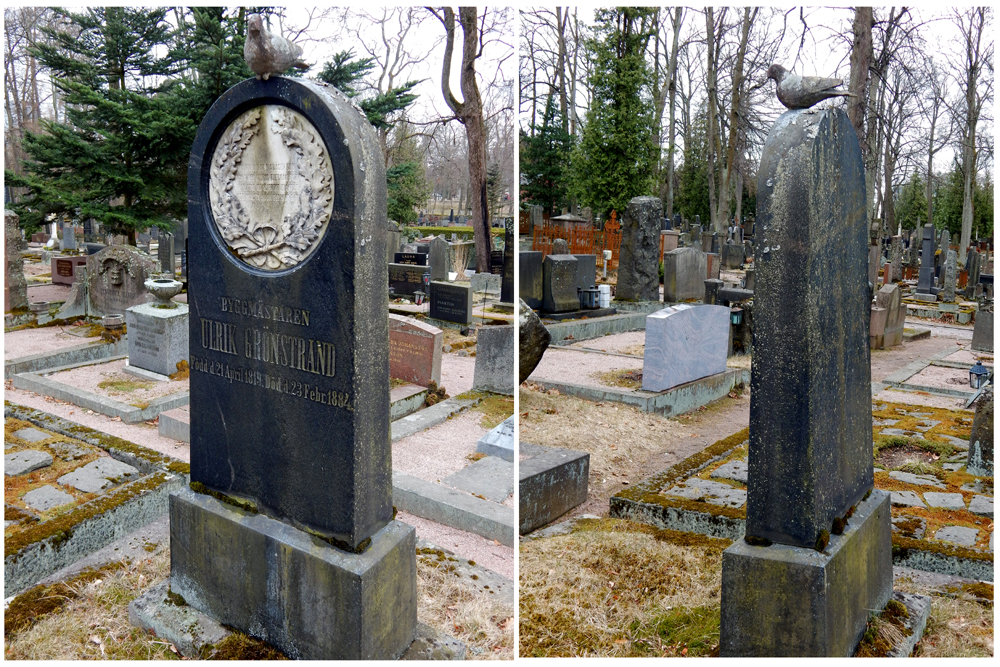
My search for information and works of sculptor Walter Runeberg (see above) led me to Hietaniemi Cemetery, where Runeberg is buried under one of his own sculptures, with several other prominent sculptures by him on other graves around the grounds. This is not Runeberg's creation, though it is clever, at least, and brilliant at best. That pigeon is permanent, part of the carving of the headstone itself.
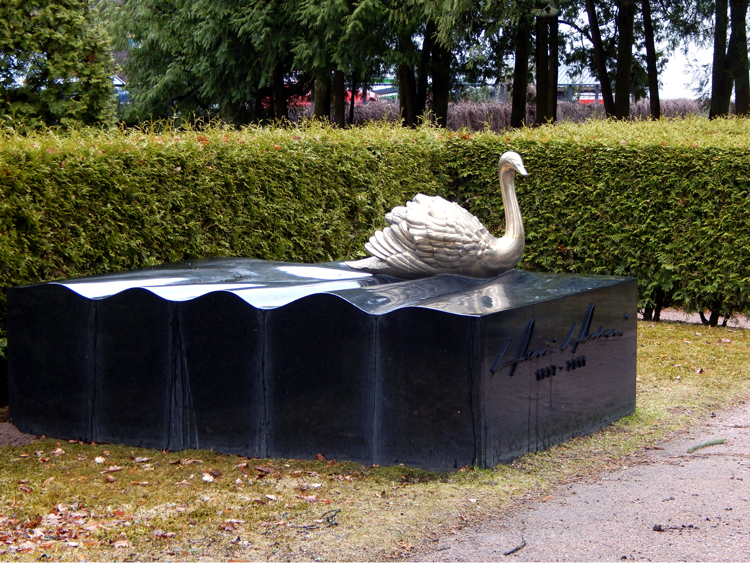
From a whimsical pigeon to a graceful swan (or is it a turkey? No, a swan). This sculpture by Pekka Jylhä (born 1955) is called Memory of the Water. It is the monument for Harri Holkeri (1937-2011), prime minister of Finland from 1987-1991. His signature can be seen on the front of the black stone base.
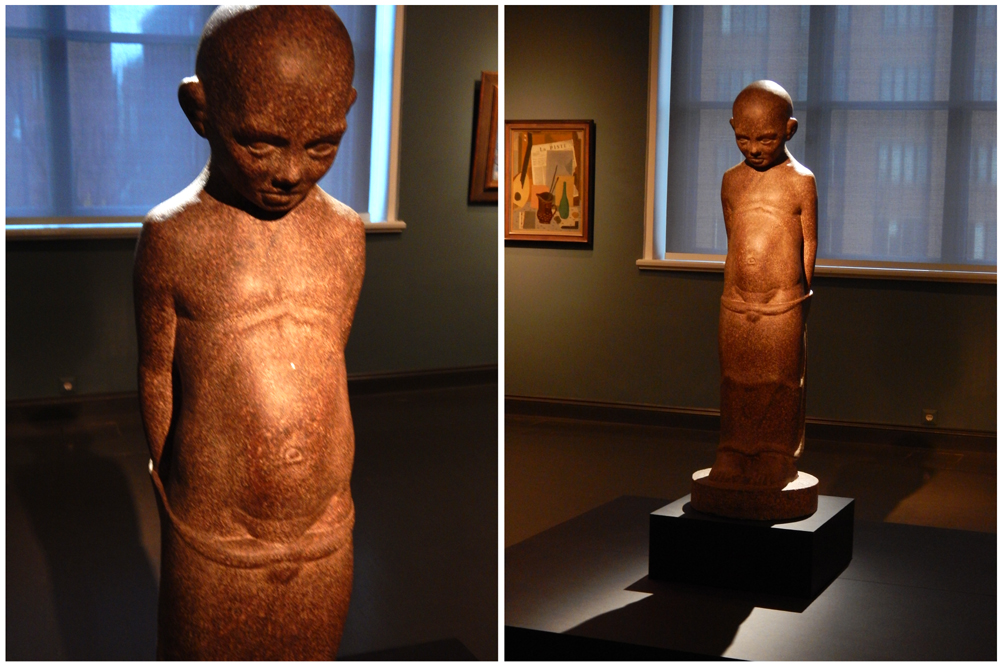
Runeberg is also represented in the great art museum, Helsinki's Ateneum, so I went there to have a look around. This sculpture by Wäinð Aaltonen (1894-1966) is nothing short of mesmerising. It's called simply Graniittipoika I, or Granite-Boy I (1917-1920).
Санкт-Петербург (St Petersburg), 27-30 April 2017
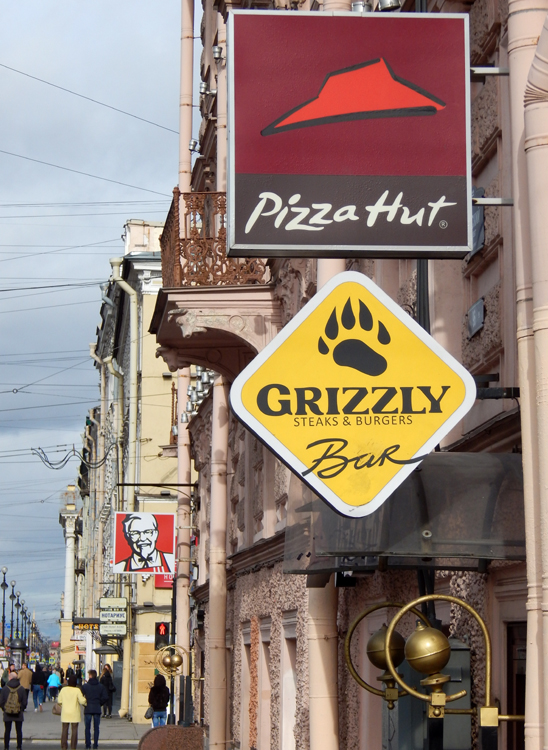
Recognise this street? Anycity U.S.A.? Easy mistake. It's St Petersburg, and not the one in Florida. How can it be that in Mother Russia, many of the restaurants are American fast-food franchises, most people in hotels and shops speak English, and virtually all the music piped into elevators and other public spaces is simplistic (and maddening) American pop?
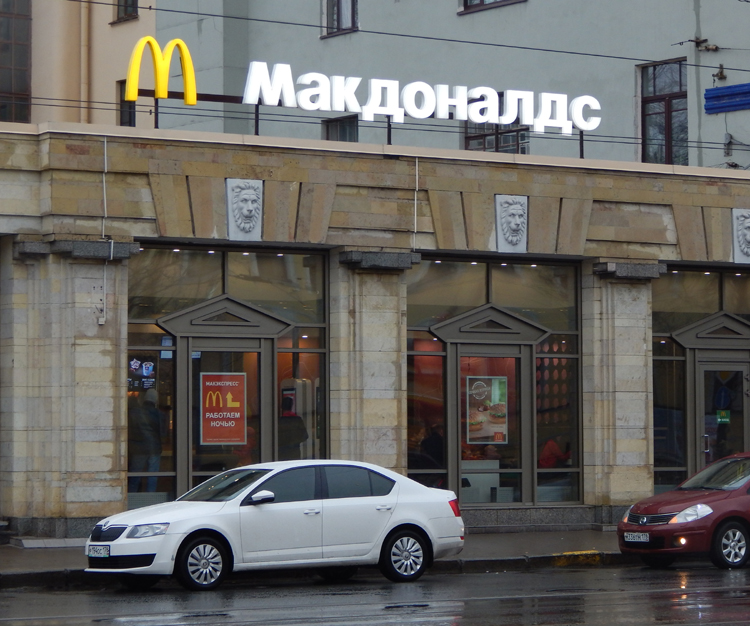
While many American-born fast food restaurant signs are just as you would see them in Muncie, Indiana, they are sometimes transliterated into Russian Cyrillic. Either by mistake or for necessity, this actually says MacDonalds (not McDonalds).
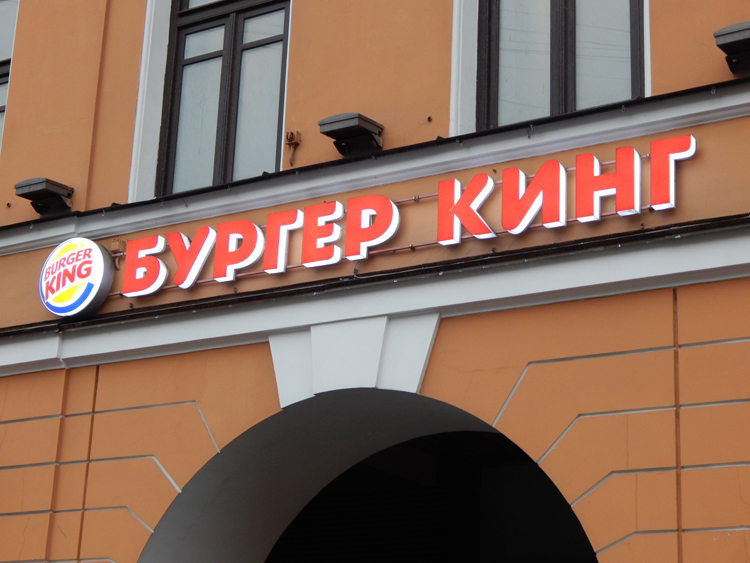
Here, to please everyone (?), we have both English and Cyrillic.
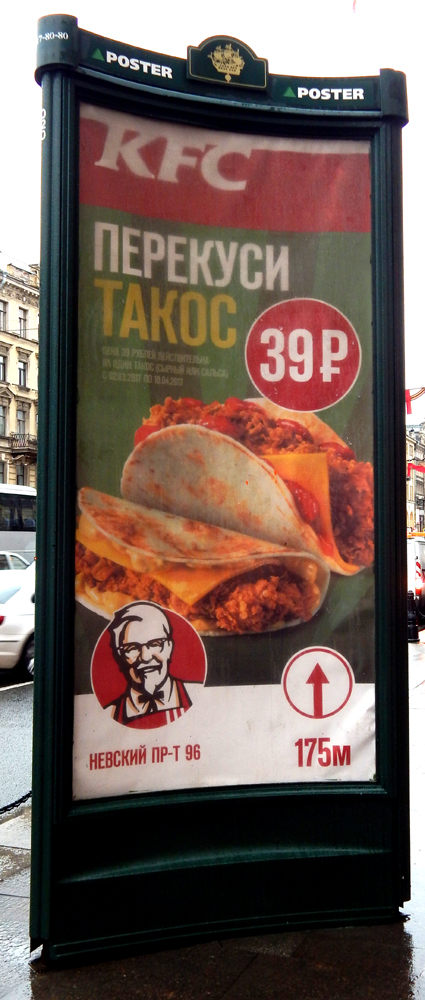
The KFC chain seemed to be the most common around St Pete, and the letters were always in English (as opposed to КФЦ, or maybe КФЧ if the final "C" of KFC is taken as "CH", since the "C" of KFC stands for "Chicken"). As for the food depicted, the Russian description (above the price of 39 Roubles) sounds like "perekusi tacos" - snack tacos. I was never able to find them anywhere, unfortunately. They look good.
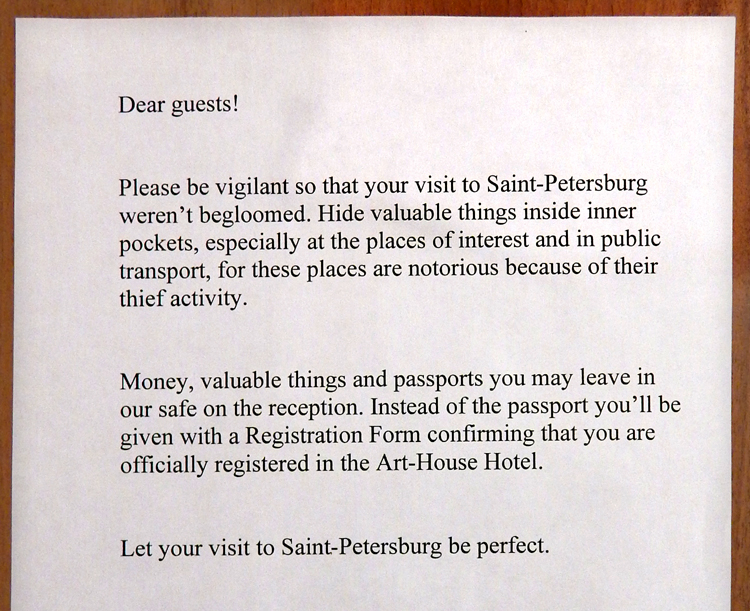
Not all English in Russia is Harvard-worthy, though there is something charming about a wish that our trip "weren't begloomed".
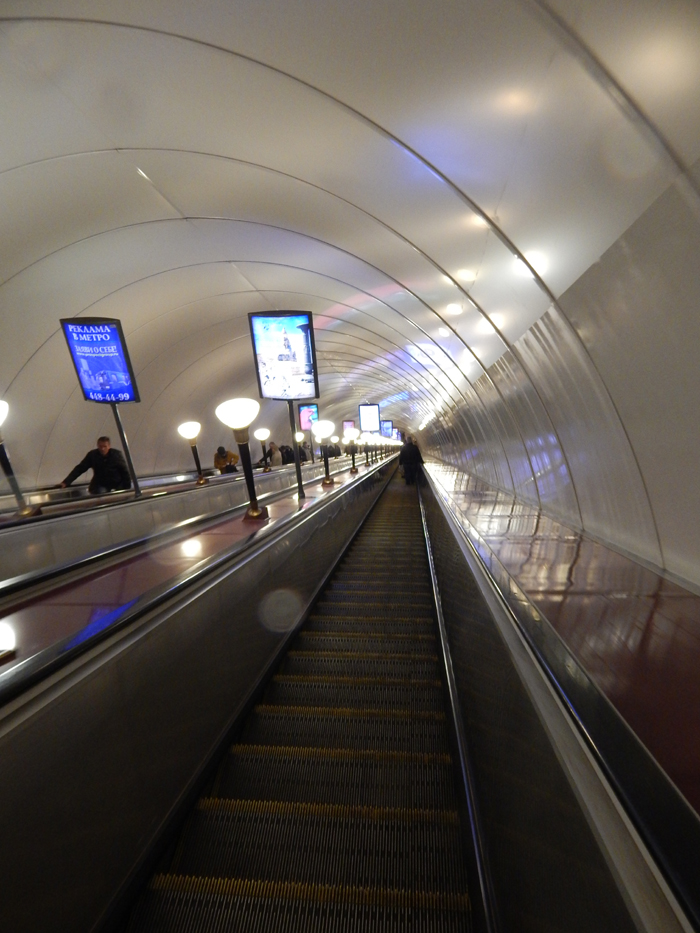
In many of the Metro stations, the escalators go so far underground that you have the impression you're going to end up in Chicago after passing the centre of the earth. This motorised stair had to be a quarter-mile long, without exaggeration. I believe it is in the Pushkinskaya Station, but many others are similarly lengthy.
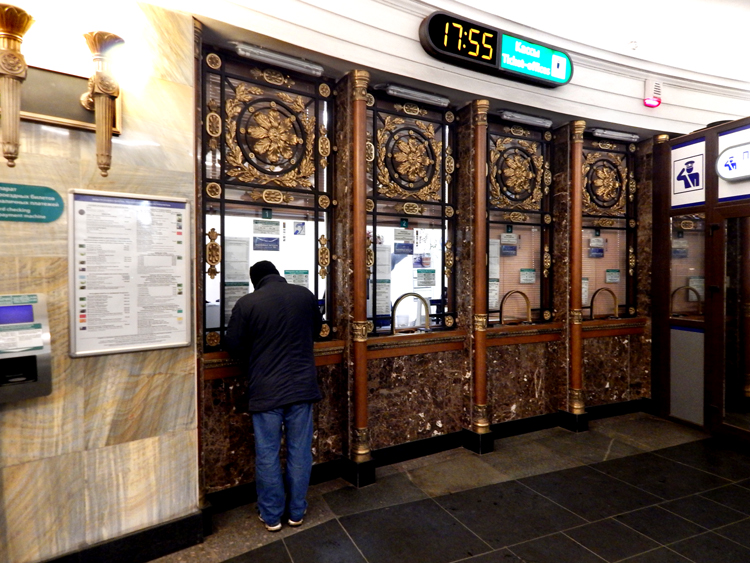
In some brochure or poster, I read that the Vitebsky Railway Station South of the city centre was a well-preserved vintage station worth a visit.
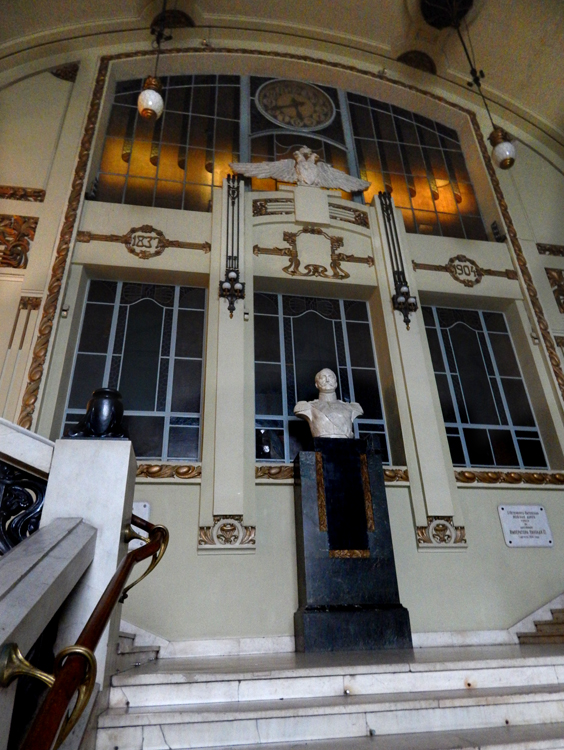
Whether well-preserved or, as signage there suggested, recently restored, it was full of interesting details. At the bottom of this stairwell, a photographer was taking pictures of a bride and groom, in full regalia. On thinking about it, it seemed a bit strange, wedding pictures in a railway station. Oh, well. When in Rome . . .
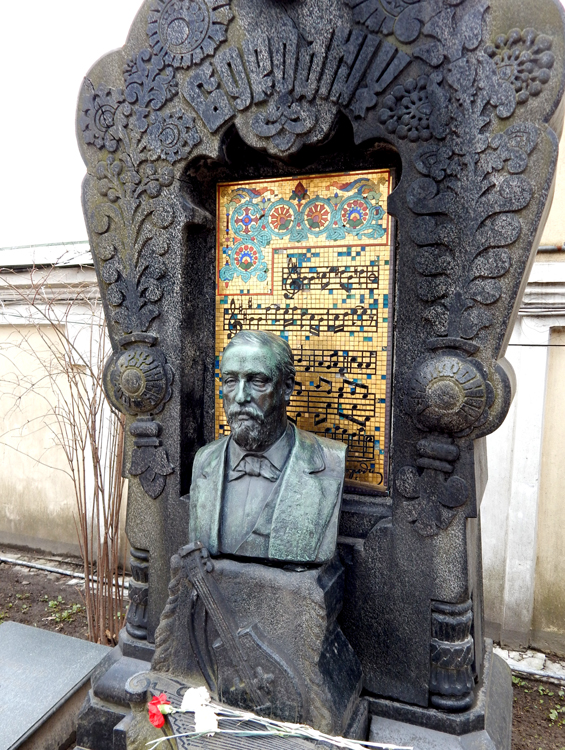
St Petersburg and Moscow got onto my itinerary because of their museums, but time permitted a visit to cemeteries as well. This is the Tikhvin Cemetery at the Alexander Nevsky (that's pronounced Nyevsky, in case you're interested) Monastery. Composers, artists and poets are buried here, as in this grave of composer Alexander Borodin. I've often seen short passages of music written on tombstones in many (perhaps most) of the cemeteries I've visited. This is the first time I've actually recognised the tune. The second line of music is from Borodin's Prince Igor, a melody made popular in the 1953 musical Kismet - "Take my hand, I'm a stranger in paradise . . ."
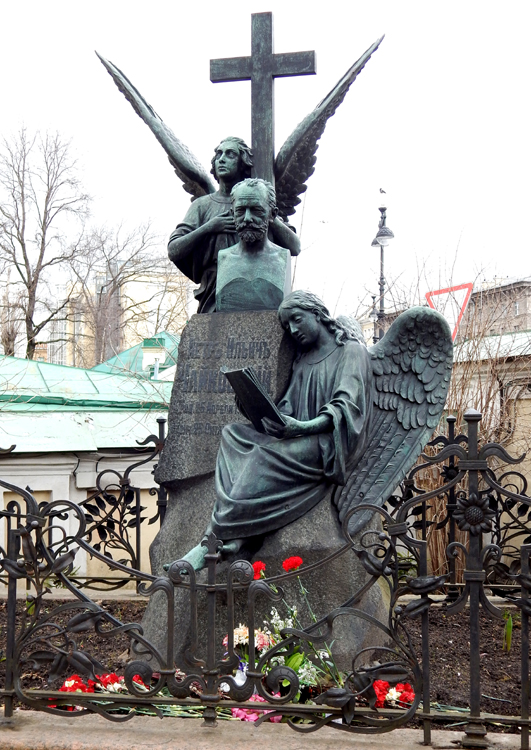
The grave of Pyotr Ilych Tschaikowskiy - and there's a million ways to spell each of his names in English.
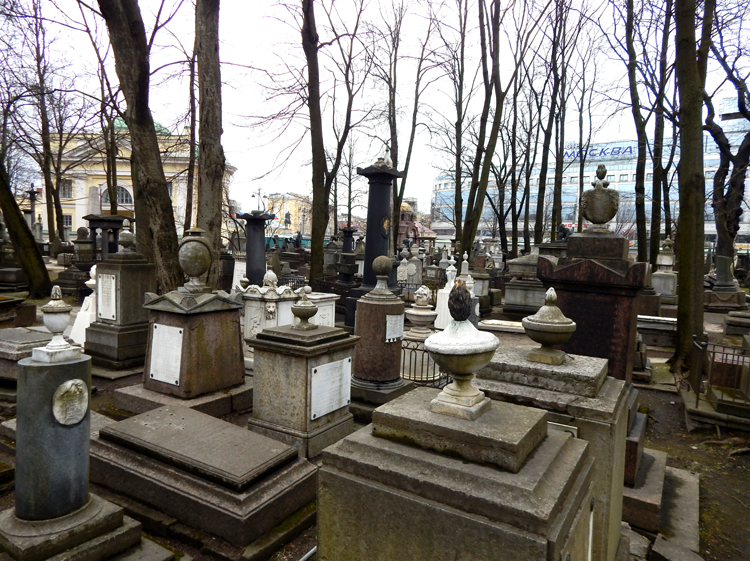
The Necropolis of the XVIIIth Century at Nevsky Monastery is much more crowded than its upscale twin across the walkway (where Tchaikovsky and Borodin, among others, are buried).
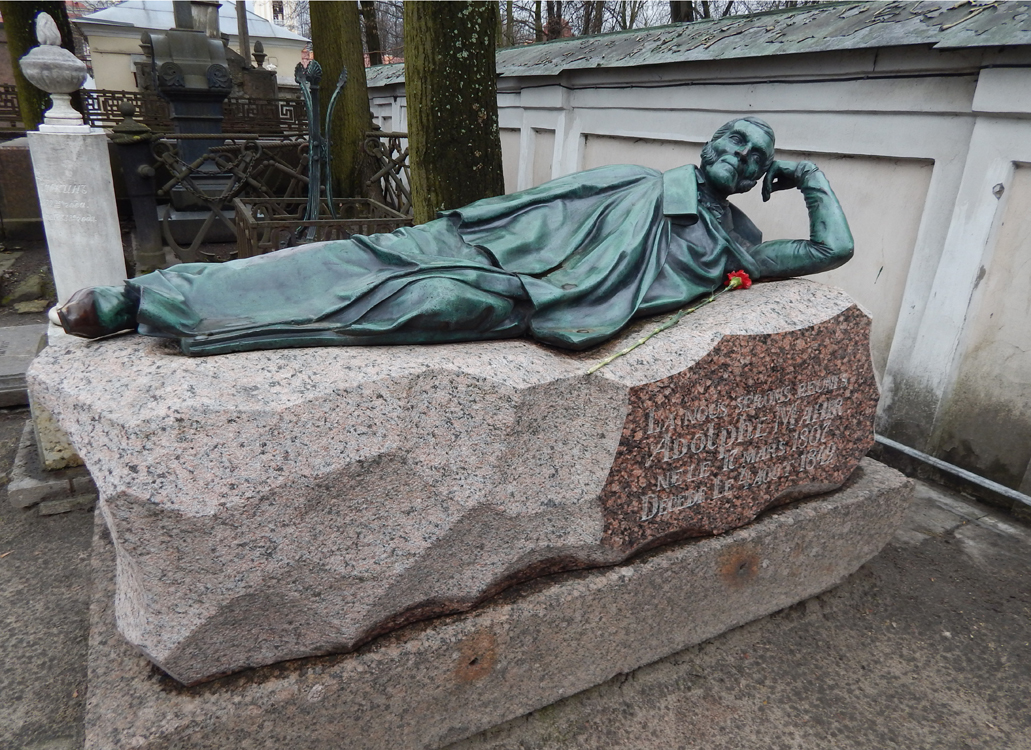
Imagine walking along among the tombs, and suddenly finding this image of Adolphe Mahir (1807-1847) just hanging out here, waiting for . . . ? It's almost unsettling, and unquestionably unusual. His inscription, by the way, is in French.
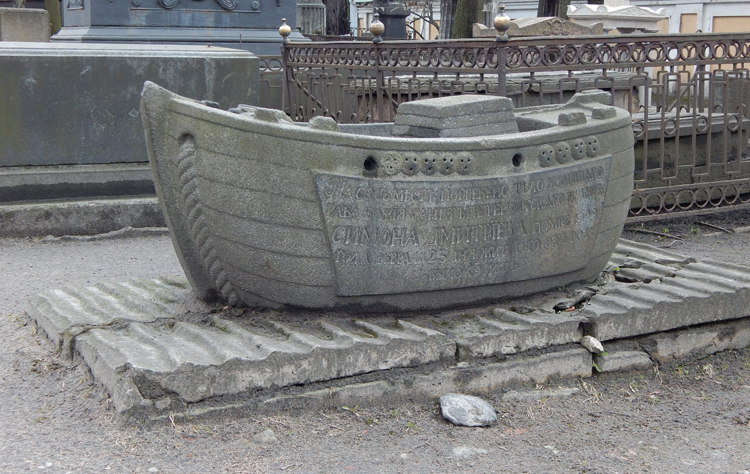
This tomb is for merchant Alexander Dmitriev, who died around 1799 at the age of about 69 (the inscription is unclear on these dates). It is a boat made of granite, apparently characteristic of tombstones of the first decade of the XIXth century.
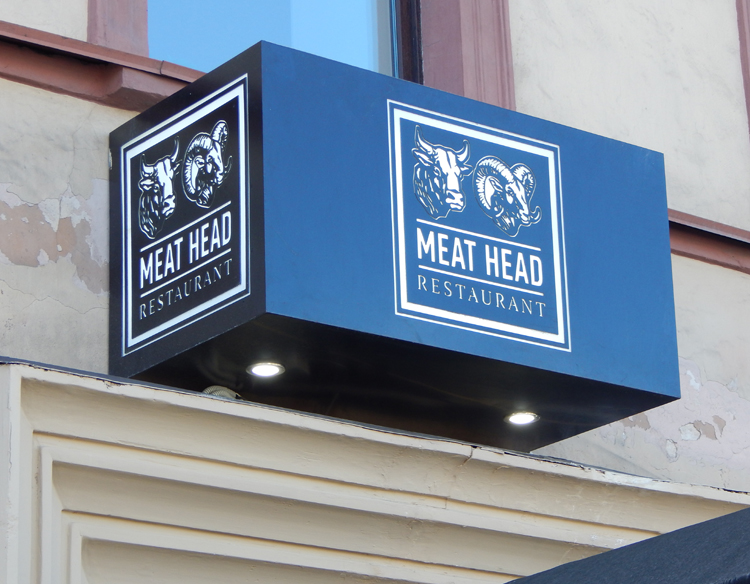
I suppose the name of this steakhouse speaks for itself. I wonder what the Russians think of the name?
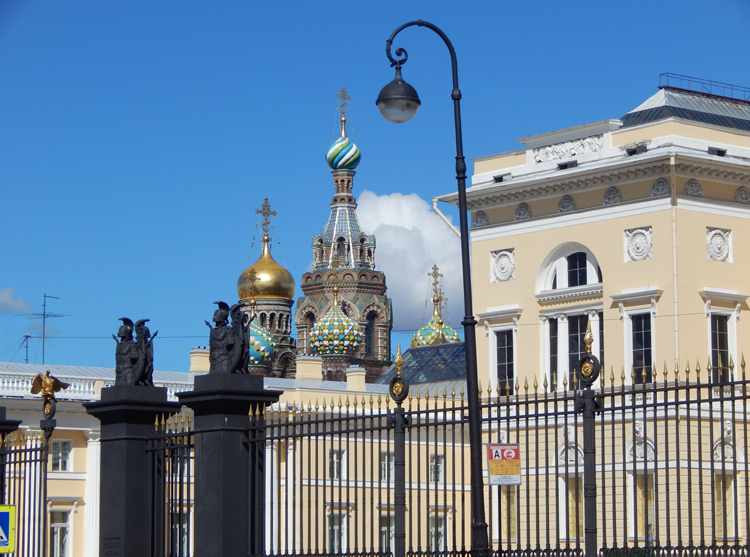
If you walk to the Hermitage Museum from the centre of the city, you might pass the State Russian Museum (the yellowish, traditional building behind the fence) then suddenly see the top of the Church of the Saviour on Spilled Blood around the corner.
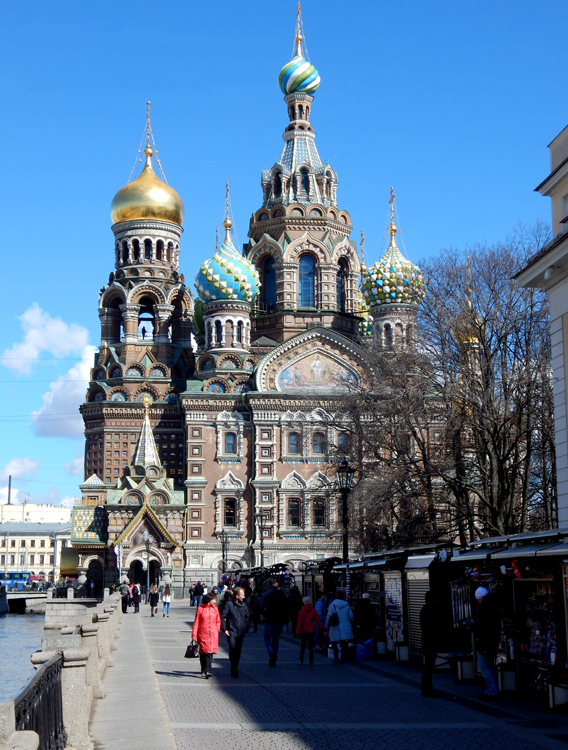
At first I thought Church on the Spilled Blood was just a misinformed translation of the Russian name into English, but it turns out it's probably correct. The church was built on the exact spot where in March of 1881 a terrorist tossed a bomb into the carriage of Tsar Alexander II (the same one commemorated in Helsinki's Senate Square, as noted above), blowing off both his legs and leading rather quickly to his death in the nearby Winter Palace.
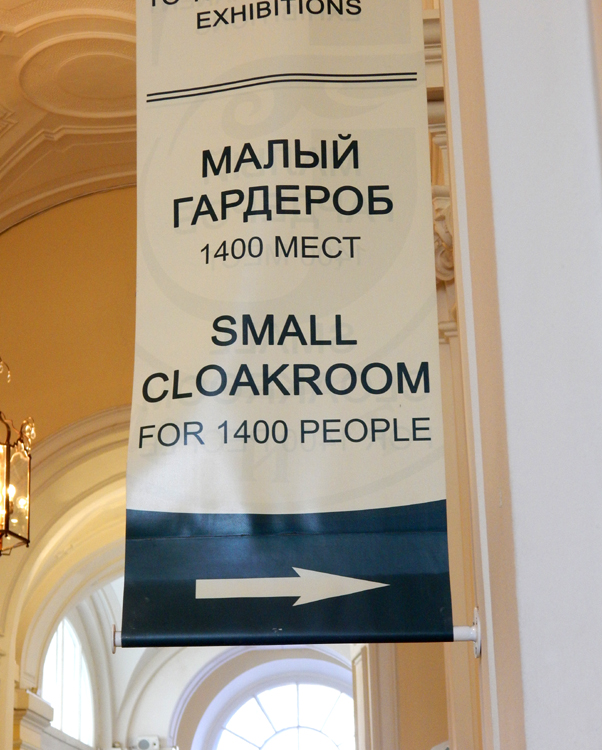
In case you're wondering, yes, there is a Large Cloakroom for around 3,000 people.
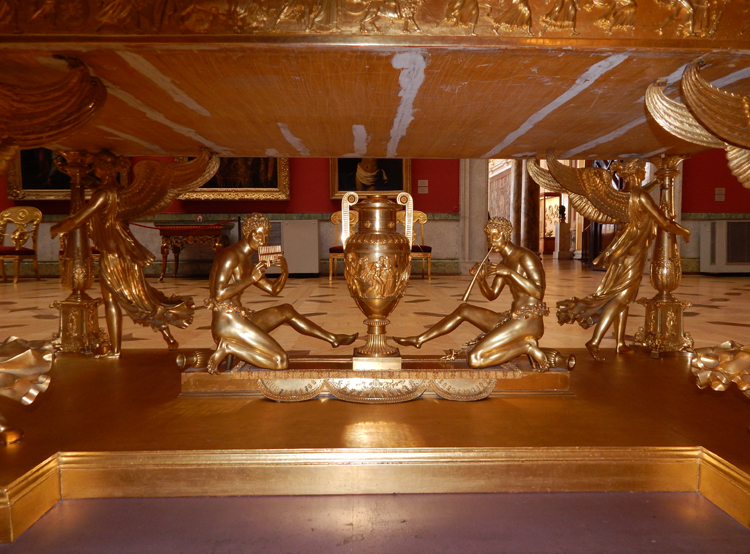
Artwork in the Hermitage sometimes is found in unexplected places, like under this gold-covered table.
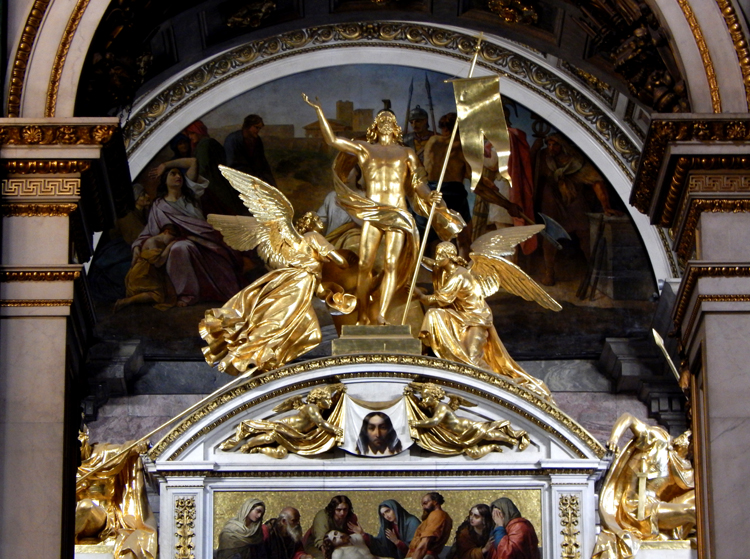
St Isaac's Cathedral is a massive, square church with chapels and altars on all sides and statues in every corner. This impressive, brilliant sculpture is high above one of the chapel gateways.
Москва (Moscow), 1-4 May 2017
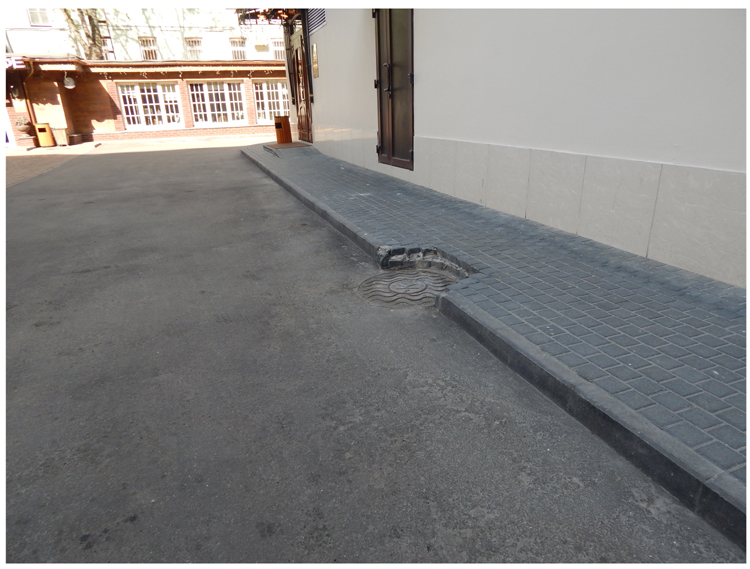
I've got some good news and some bad news about Moscow. First, the bad news (for me). This hole in the walkway in front of my hotel's main door cannot be seen at night, as the courtyard is not lighted. It can, however, be stepped into unexpectedly with dire consequences. After falling flat on my chin and bruising ribs and kneecaps, I felt those consequences for most of the rest of my monthlong trip. Did I say trip?
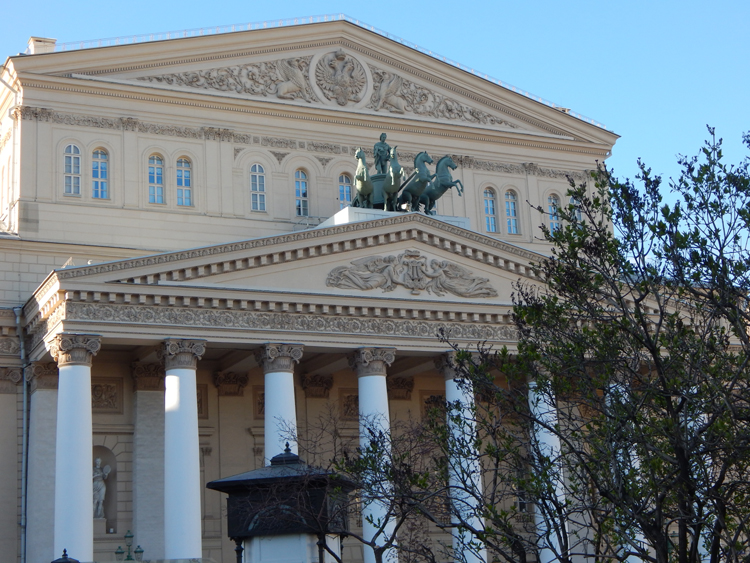
The good news is that Moscow is wide open to tourists, and virtually free of the propaganda that one might have expected in the Soviet era. The open-top bus tour, as usual, had commentary in English, where I learned one of the pre-Soviet era jokes that used to circulate: "Where in Moscow can you find the only taxi driver who isn't drunk? Apollo at the Bolshoi." That's Apollo on the roof, driving his quadriga, completely sober.
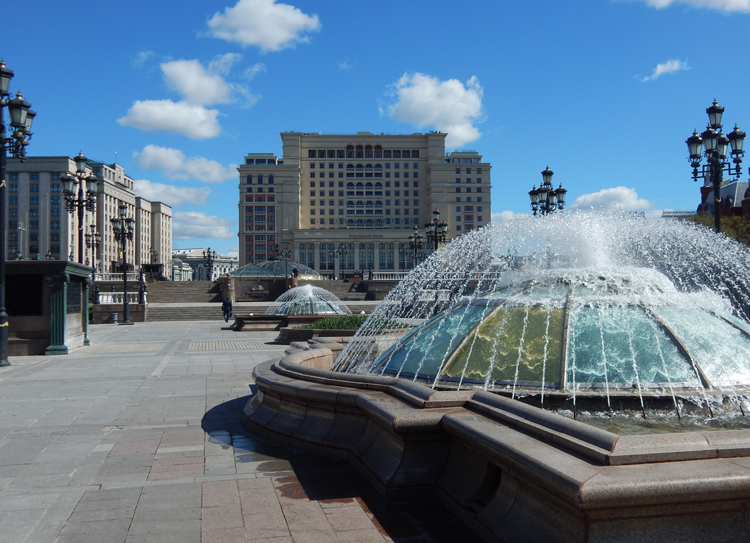
Another anecdote told by the open-air bus commentary has to do with the design of the Moskva Hotel, now known as the Four Seasons Hotel. As the story goes, in the early 1930s the architect submitted for government approval a single drawing of the building, with different designs for each of the two wings. Stalin signed the drawing in the middle, thereby leaving the architect wondering which of the two designs he should use. Afraid to go back and ask Stalin which design he liked better, the architect just went ahead and built the two wings with different designs. Strangely, when the hotel was completely demolished and rebuilt in 2004, the original design was retained, making the new building look nearly exactly the same as the old one.
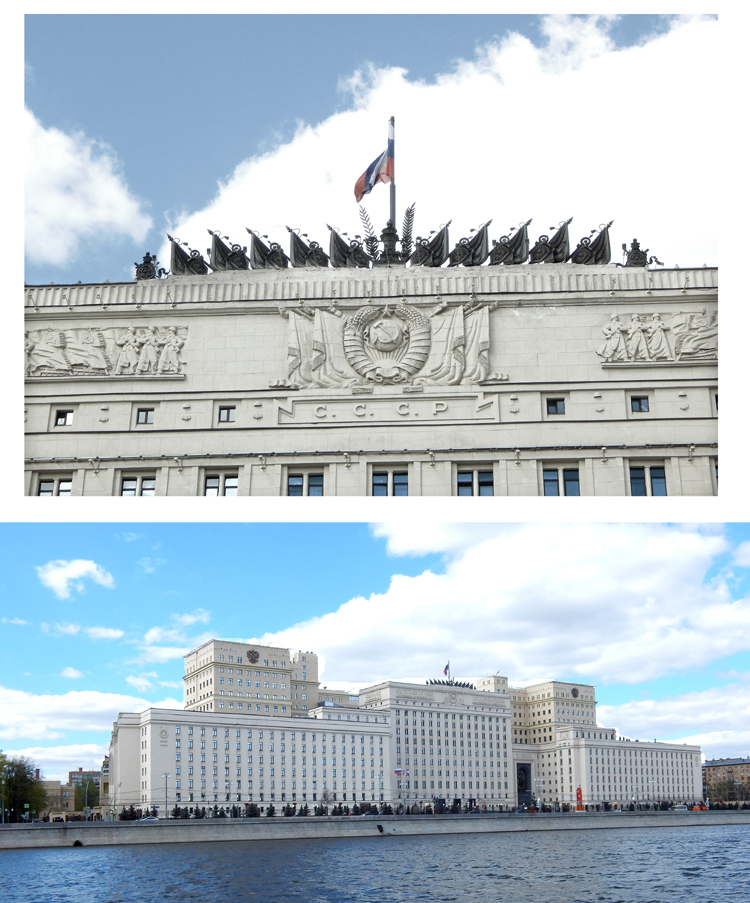
This, for me, was the building that looked the most Russian, in the Soviet sense. It's the Ministry of Defense, a massive monolith along the Moskva. At the top, centre, is the iconic hammer and sickle, above the Cyrillic letters C.C.C.P. (S.S.S.R. in Roman letters, the acronym of "Soyuz Sovetskikh Sotsialisticheskikh Respublik"). The English version of that is U.S.S.R. - Union of Soviet Socialist Republics. Confused? Don't worry. It's only history, now, anyway.
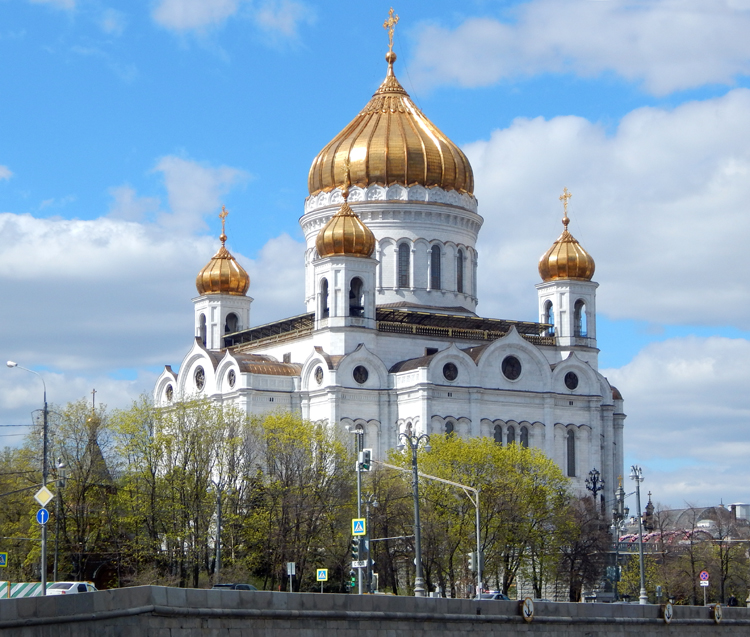
How old do you think this building is? The Cathedral of Christ the Saviour, near the Kremlin, was built during my lifetime, and maybe even yours, between 1995 and 2000. The original XIXth century church took 40 years to build, and was destroyed on Stalin's orders in 1931. He wanted to build a massive Palace of the Soviets on the site, but the Nazi invasion of 1941 and Stalin's death not long after halted those plans. The foundation hole for the unbuilt Soviet Palace remained and, as it was flooded at every rainstorm, Nikita Krushchev decided to make it official, and the world's largest outdoor swimming pool was constructed there, before the Russian Orthodox Church finally got permission to rebuild their cathedral. What a distinguished history, eh?

MINIMARKET. That just can't be an original Russian word!
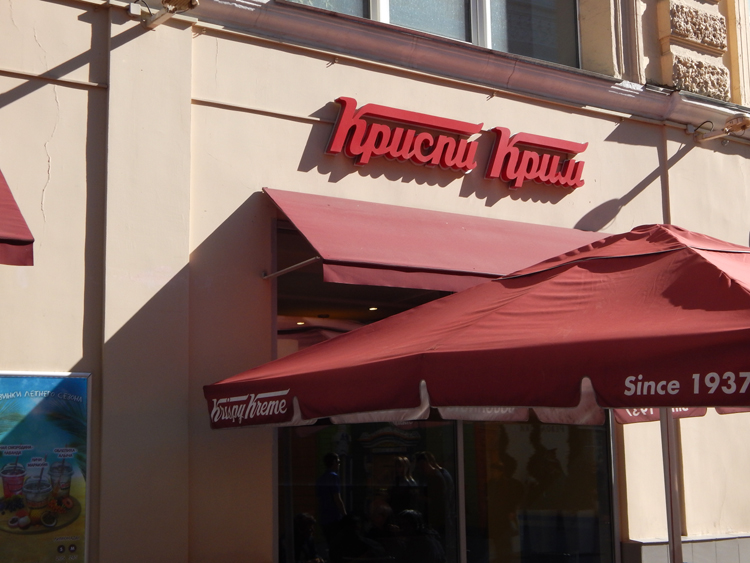
How unlikely is a Krispy Kreme store in Moscow, let alone half a block from Red Square? Yes, of course, I tried one - and it was absolutely, spot-on authentic.
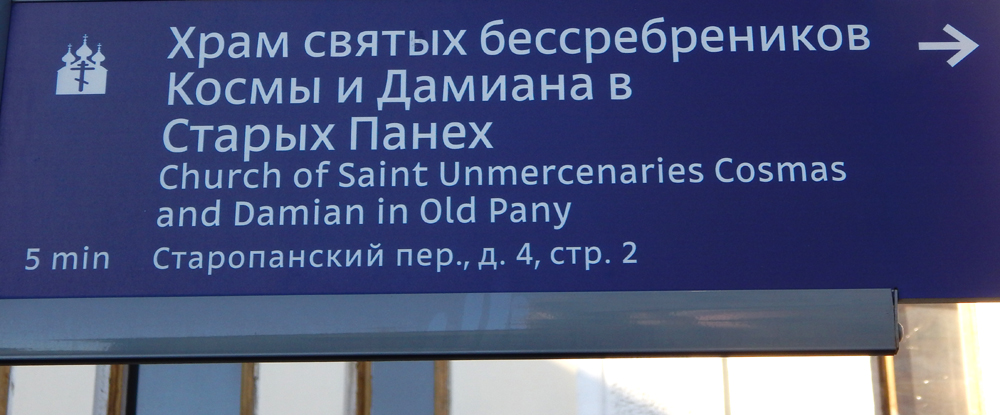
I've read this sign a number of times, and I still can't figure out what it means, except that somewhere in that direction there's some church or another.
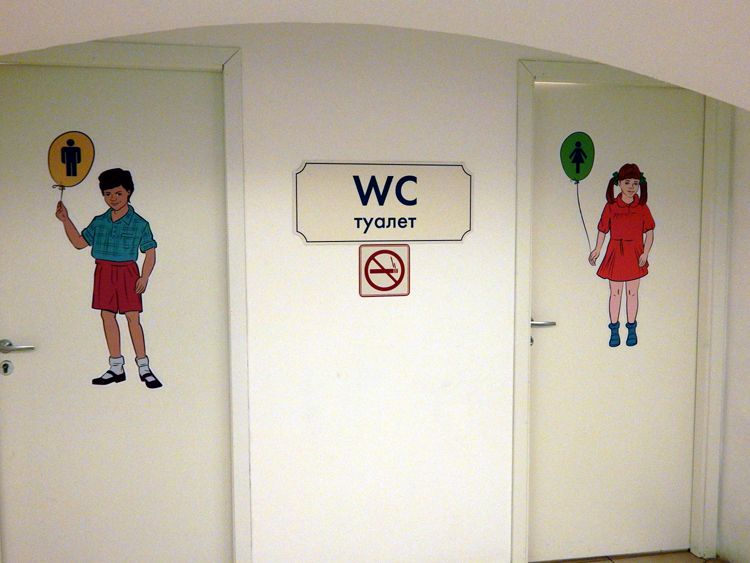
Maybe it's just me, but these signs designating the toilets in the upscale Gum department store make me squirm a bit.
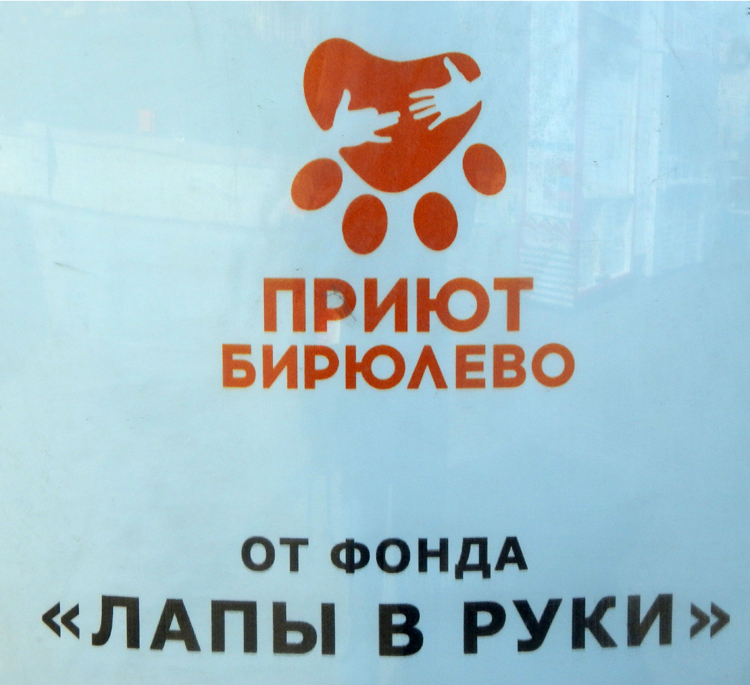
The logo for this animal rescue group is absolutely inspired.
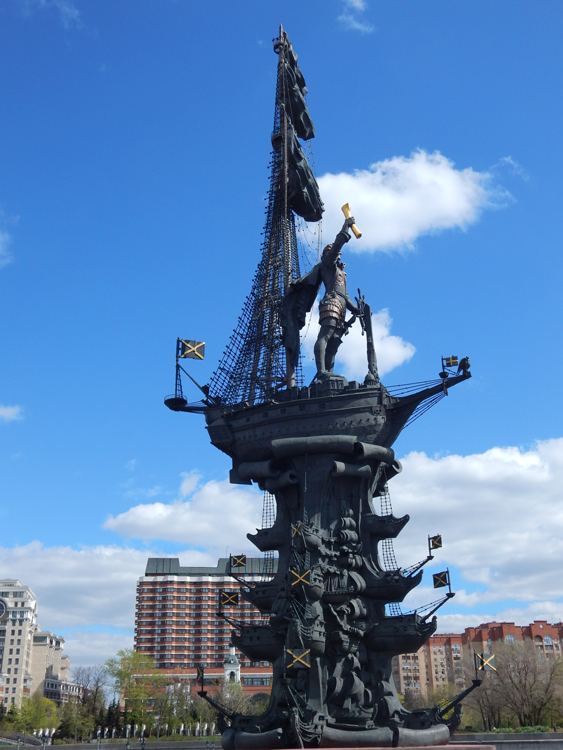
This statue of Peter the Great, erected in 1997, is not inspired. It's horrendous, not to mention monstrous (in many meanings of that word). Critics have not been kind to the statue, with one saying it should be shipped off to St Petersburg (its namesake city), or anywhere else but Moscow. I doubt it could be moved by any conveyance currently known to humankind, though. It's 98 metres high and, according to its Wikipedia page, weighs 1000 tons!
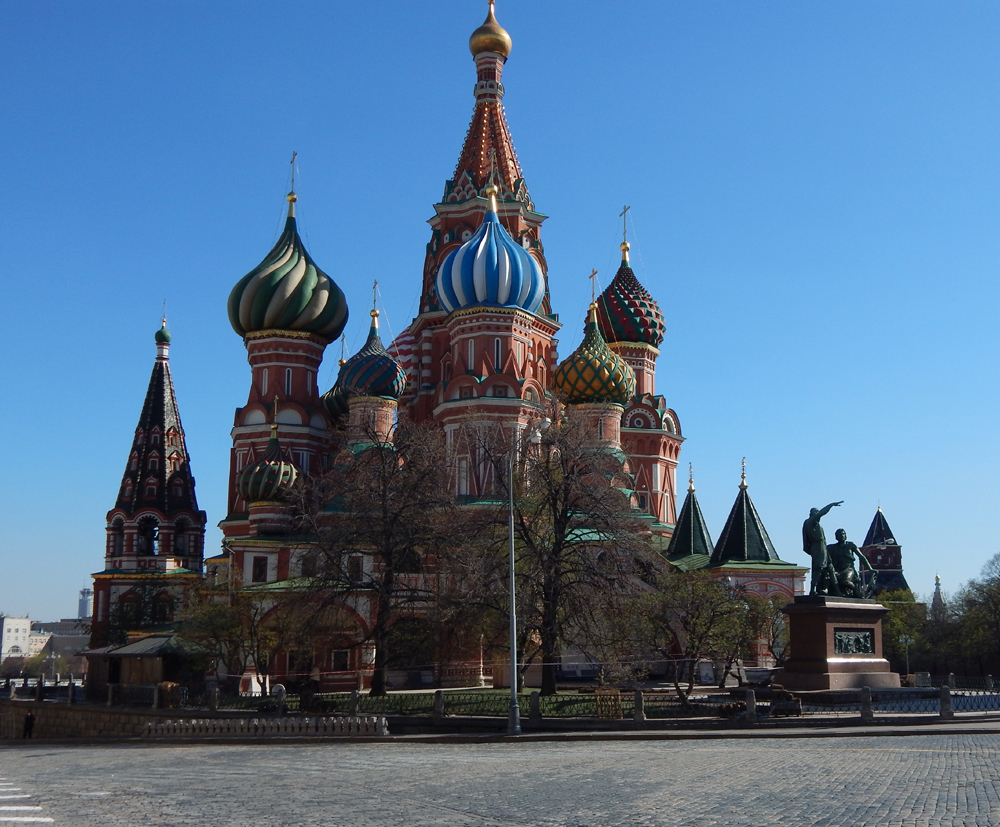
Unquestionably the most recognisable icon in Russia is St Basil's Cathedral on Red Square. Here we also see a statue of Lenin to the right.

From iconic St Basil's to this skyline, which I wouldn't have been able to identify as Moskovian even with a week to think about it. It is, however, distinctive and in time may become part of Moscow's international identity.
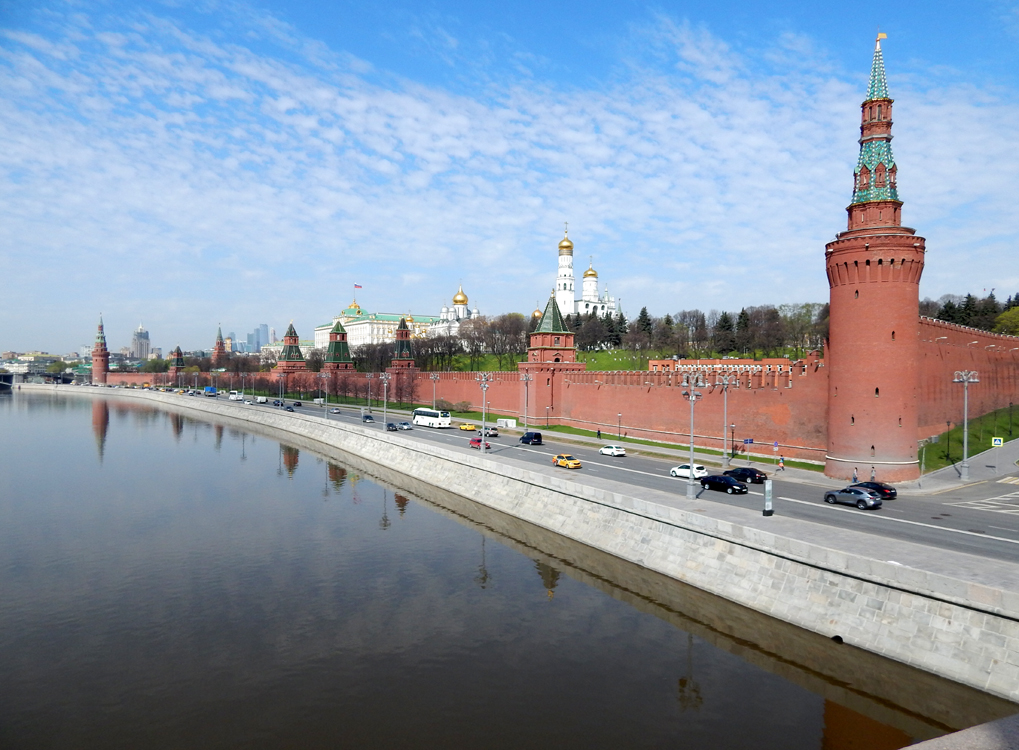
It is said (at least by the open-air-bus commentary, where I got most of my information about the cities I visited) that during the War, windows were painted onto the walls of the Kremlin so that enemy bombers would think it was apartment buildings.
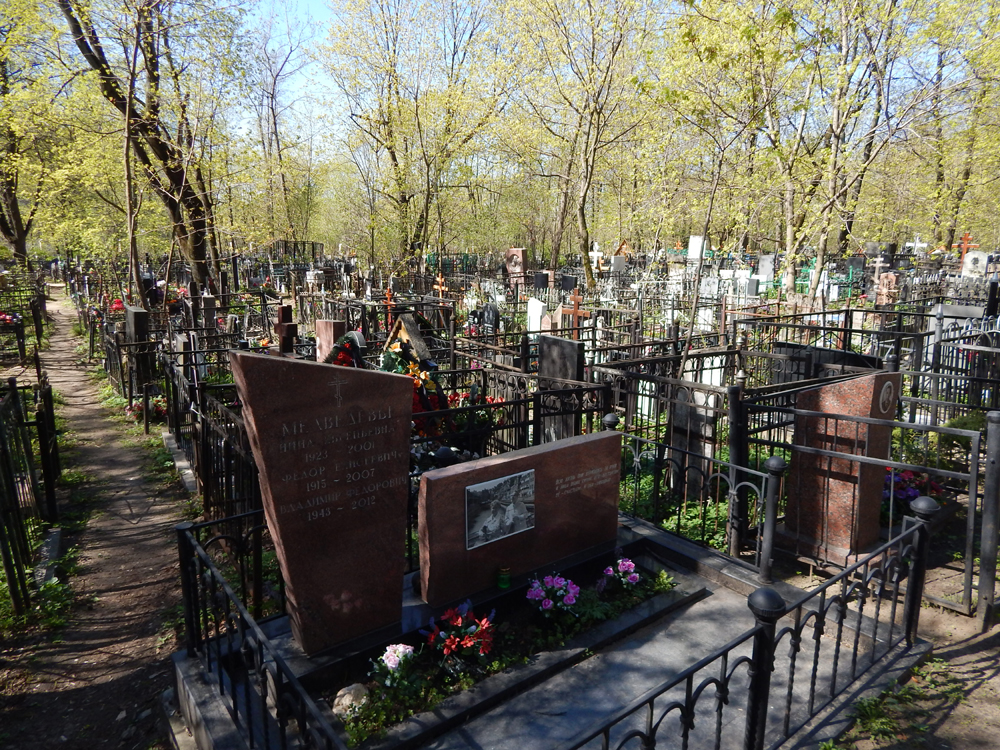
Moscow's Vaganskoskoye Cemetery is different from others I've seen, in that most of the graves or family plots are enclosed in their own, individual iron fences. I thought about this during the few hours I was there, and couldn't come up with any reason why the population of Moscow would think this is important, when their comrades in St Petersburg (the only other Russian city I visited) didn't seem to follow the same custom.
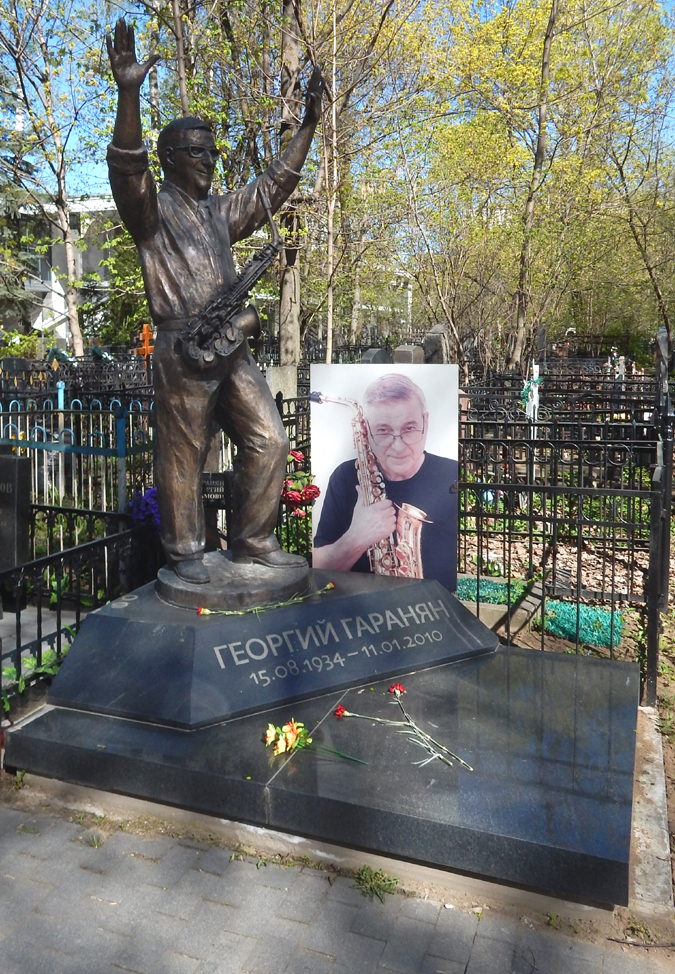
Some grave monuments - also called funerary art - emphasise grief or loss, others celebrate the life of the deceased. This grave of Georgiy Garanyan (1934-2010) is obviously a celebration.
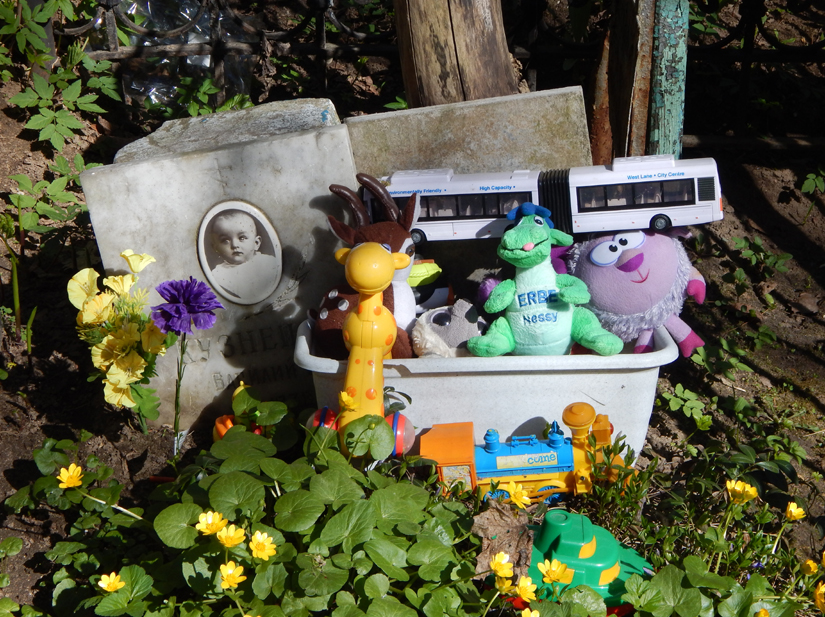
Baby graves are touching and sad, especially when one imagines the feelings of families on losing one of their own before they even get the chance at life. Some cemeteries, such as Staglieno in Genova, have entire sections for the graves of babies and young children. Leaving assorted toys on the grave is probably similar to the ancient Egyptian custom of burying clothing, possessions, and even food as provision for the deceased in the afterlife.
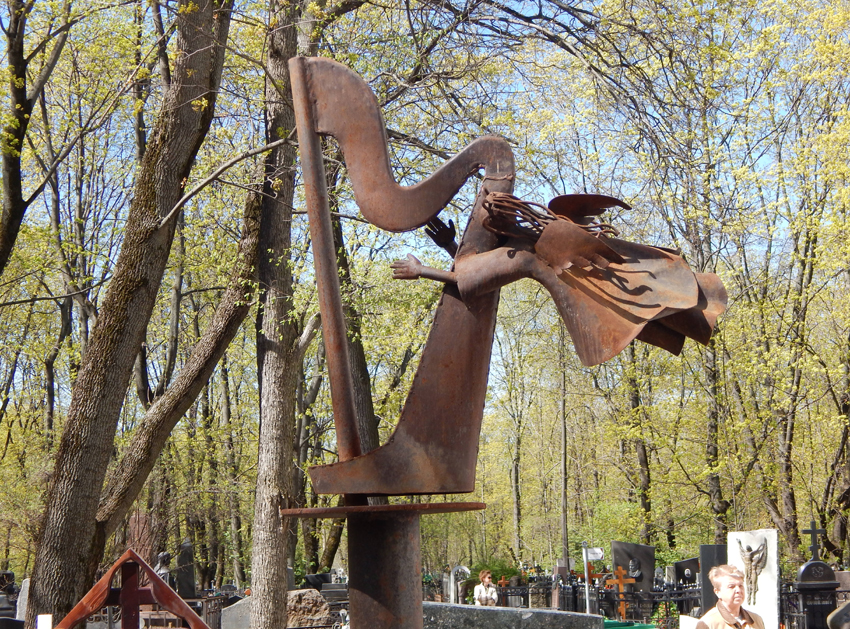
The grave of sculptor Daniel Yudovich Mitlyanskiy (1924-2006) is a tribute to him as well as his profession. It is not clear if this is one of his own sculptures.
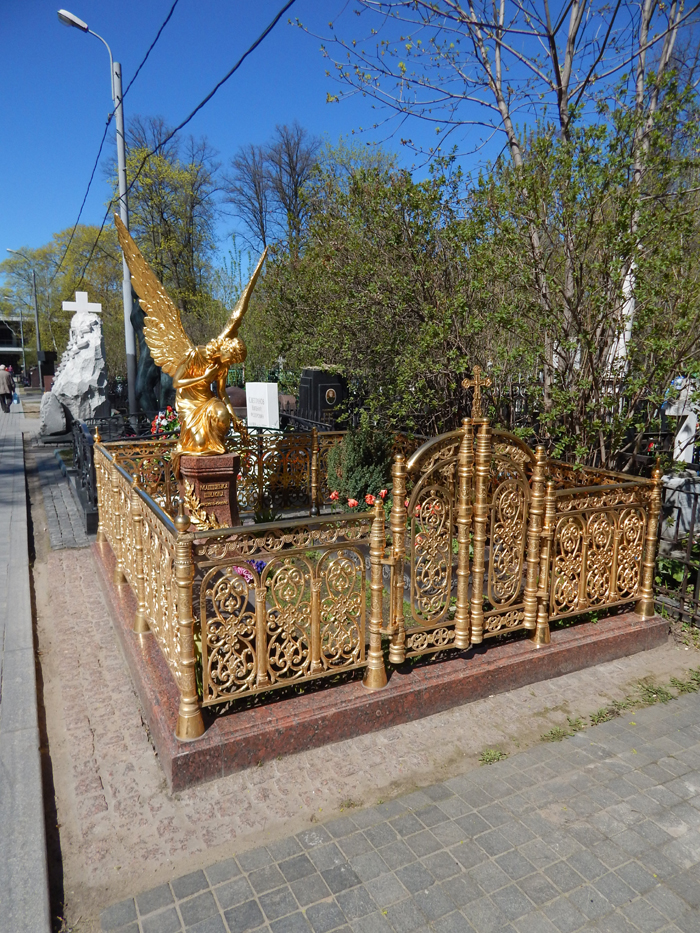
This grave stands out from the rest, for obvious reasons. It is the resting place of Maria Aleksandrovna Shilova (1979-1996), daughter of artist Alexander Shilov.
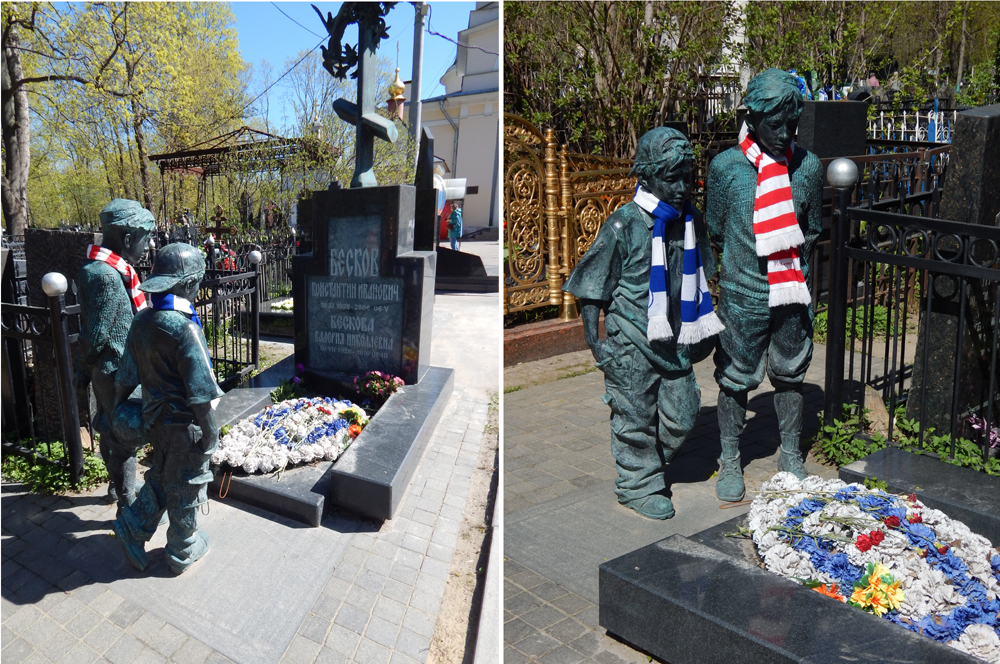
Sometimes, a grave monument grabs the passer-by and won't let go. I don't mind admitting this monument for the Veskov family is heartbreaking. The mufflers around the boys' necks are regular knit fabric, perhaps placed by family members in the way that others place flowers on a grave from time to time.
Above, I noted that most plots at Vagankovskoye Cemetery are enclosed in iron fences. In the background of the picture on the left, you can see one that even has a wrought-iron roof. In the picture on the right, you can see that this grave for the Veskov family is just next to the grave shown in the previous picture for Maria Shilova.
Bucureşti (Bucharest), 5-7 May 2017

My impression of Bucharest was that it looked the same today as it did 80 years ago. Some would call it dilapidated. I call it charming, my favourite city on this trip. (This is the intersection at Piata Romana.)
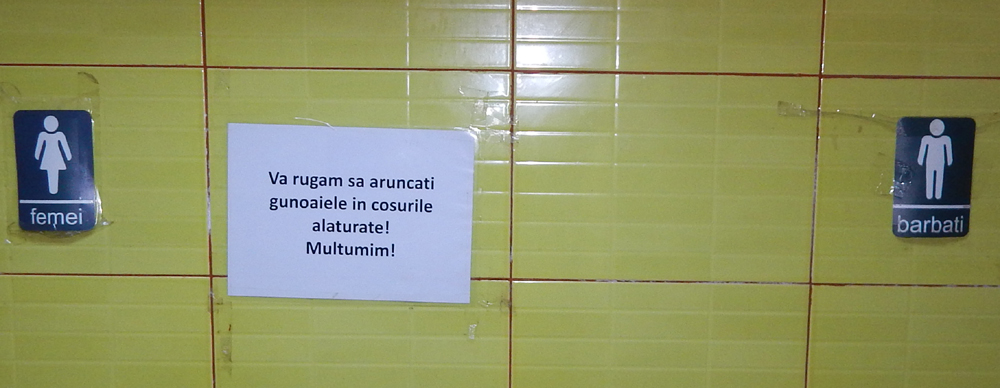
Romania is so named because of the influence of Roman settlers long ago. The language, also, is very "Latin", giving us labels for the toilets that you see here. Hopefully, the boys and very young men of Romania are able to generalise their label, as the word "barbati" literally means "bearded". There is a crass joke in there about Romanian women, also, but I won't go there. The printed, taped-on sign in the middle says something about throwing trash into the "adjacent pockets".
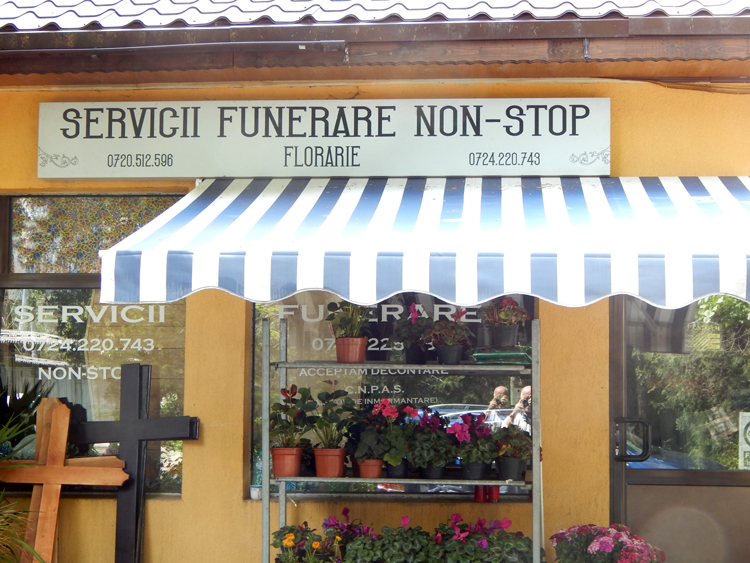
Many businesses in Bucharest have "Non-Stop" added to their business signs. I never found out exactly what it meant. This, for example, is a flower shop at a cemetery. It's obviously not drive-through, isn't open 'round the clock, and certainly doesn't have a steady stream of customers, so what could "Non-Stop" mean?
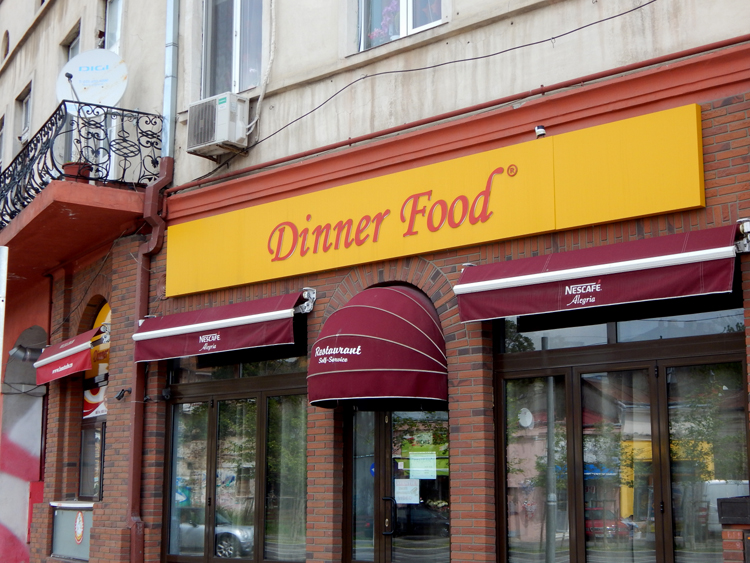
This restaurant takes the cake, so to speak, for the most direct, no-nonsense name. If you look closely, you can see that it's a registered trademark, not just an informative label.
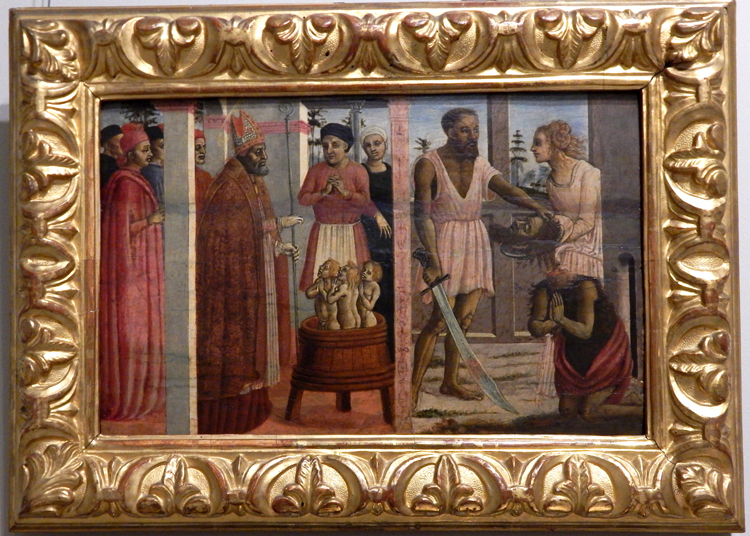
This painting is unusual in structure - two different and unrelated images framed together - and in content. On the left is The Miracle of St Nicholas of Bari, and on the right is The Beheading of St John the Baptist. I don't know what St Nicholas's miracle is, but maybe it's being able to make those tiny children stand up on their own. As for St John, his head has been completely separated from his neck, and still he's kneeling and praying. Artistic licence is the only explanation.

As you may know from previous vacation pictures, I find the hand positions in religious paintings intriguing.
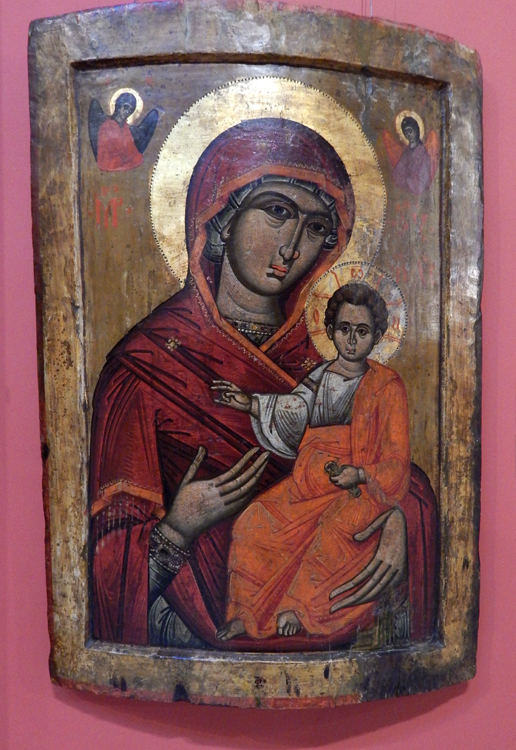
Hand gestures were used by early Christians as code to acknowledge other Christians and at the same time avoid being identified as such.
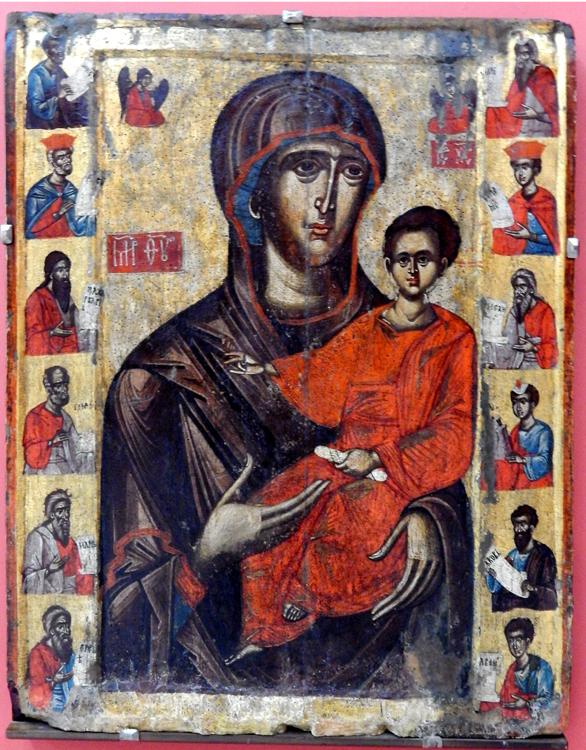
I find them particularly interesting when the "signal" is being given by the baby - or at least very young child - Jesus himself. Such dexterity!

I can't avoid drawing the comparison between these early Christian gestures and the hand signals used by gang members in contemporary (American) society, no disrespect to either group intended. Other modern examples include the "victory" sign, often associated with Winston Churchill or Richard Nixon; and the iconic "live long and prosper" gesture, firmly embedded in XXIst century culture, courtesy of the Star Wars franchise.

Bucharest does have a couple of world-class museums which I was glad to visit. This painting of Carlo Broschi (1705-1782) was done by Jacopo Amigoni when Broschi was in his early 30s. It becomes much more interesting when we remember that Carlo Broschi was better known as Farinelli, one of the most famous of the castrati, who were probably the XVIIIth century's equivalent of rock stars.
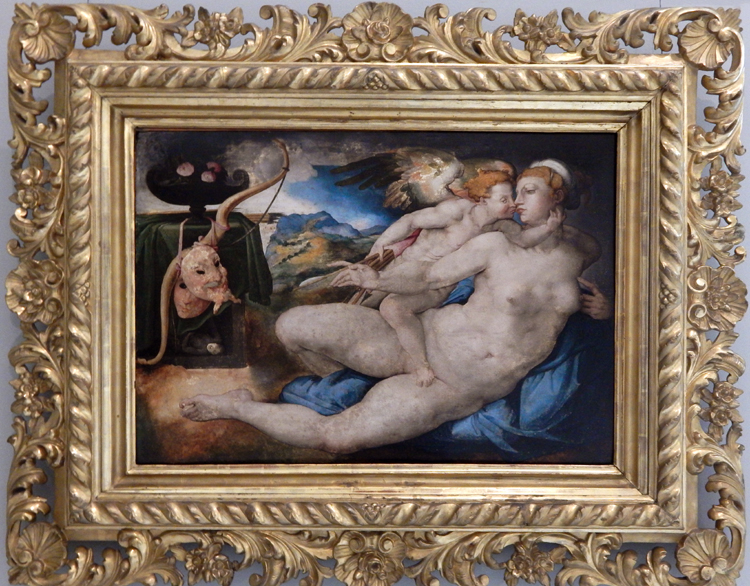
This painting of Venus and Cupid turned out to be a curiosity, beyond its somewhat bizarre (in my opinion) content. The Bucharest Art Museum where it hangs has an information card that identifies it as the work of Bronzino (1503-1572), also known as Agnolo di Cosimo. Many sources on the Web, however, show an almost identical painting by Bronzino's mentor, Jacopo da Pontormo (1494-1557) in the Uffizi Gallery in Firenze (Florence), Italy. The only difference - in an extremely detailed painting - is a bit of fabric just under Cupid's right foot. It's a mystery to me.

The mausoleum of the Tanasescu and Athanasiu families at Bucharest's Bellu Cemetery, detailed and unusual.
Budapest, 8-10 May 2017

I took this typical tourist picture of Buda, the Danube and Pest (right to left) from Buda Castle in order to tell a story. According to reports I heard on the open-top bus tour, roughly 80% of Pest (the portion of BudaPest on the left here) was destroyed during World War II by hostile (Soviet) artillery, mostly firing from that green hill you see here on the Buda side. A considerable portion of the rebuilding of the city was replication of the previous architecture, sometimes through photographs. The result is that BudaPest (or, rather, mostly Pest) looks like an old, established city, unlike Berlin, which seems to be mostly 1950s modern.

About a decade after World War II, Budapest (and, probably, all of Hungary) had had enough of Soviet rule. The result was the 1956 Revolution. Among the heroes were very young men, whom many today would call boys, or children. One particular place where many very young soldiers resisted - and died - is Corvin köz, where this memorial stands.
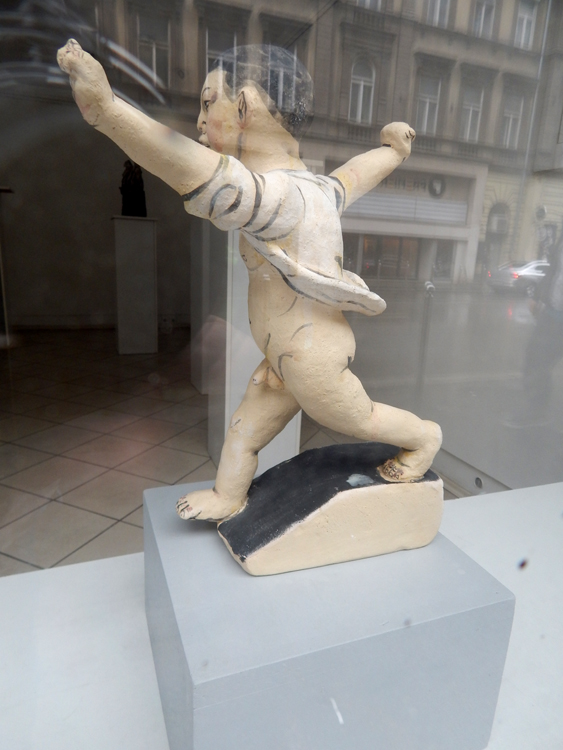
Small figurine in the window of an art studio/gallery.
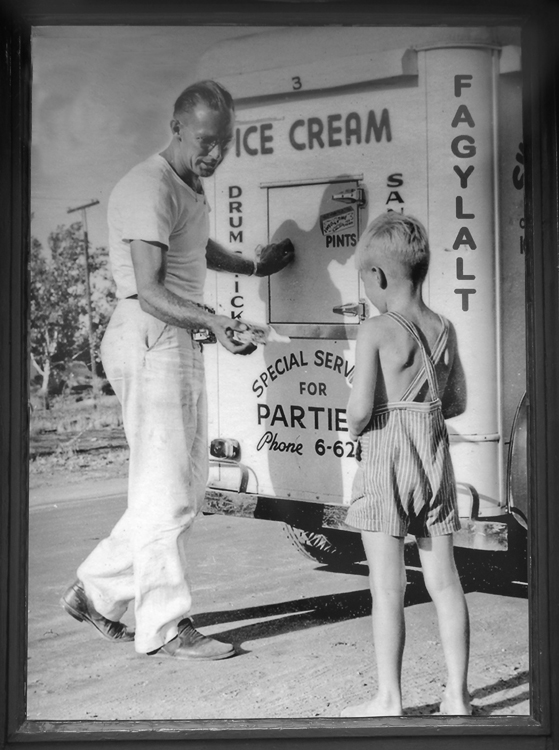
This undated photo - looks to me like 1950s - is interesting because, except for the Hungarian word "fagylalt" (ice-cream), everything else, including the phone number, is in English.
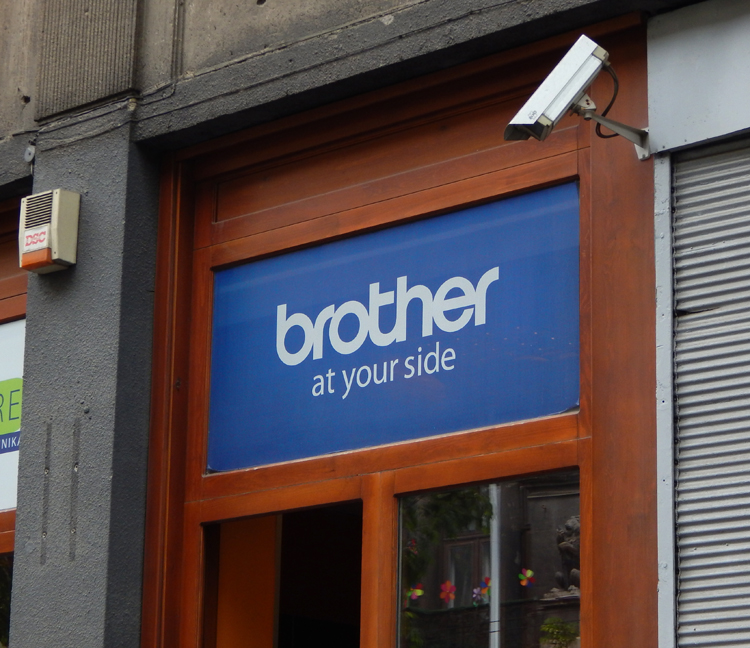
The juxtaposition of "brother" (Big or not) and a security camera was just too tempting as a comment on contemporary society. (Orwell, please come back.)
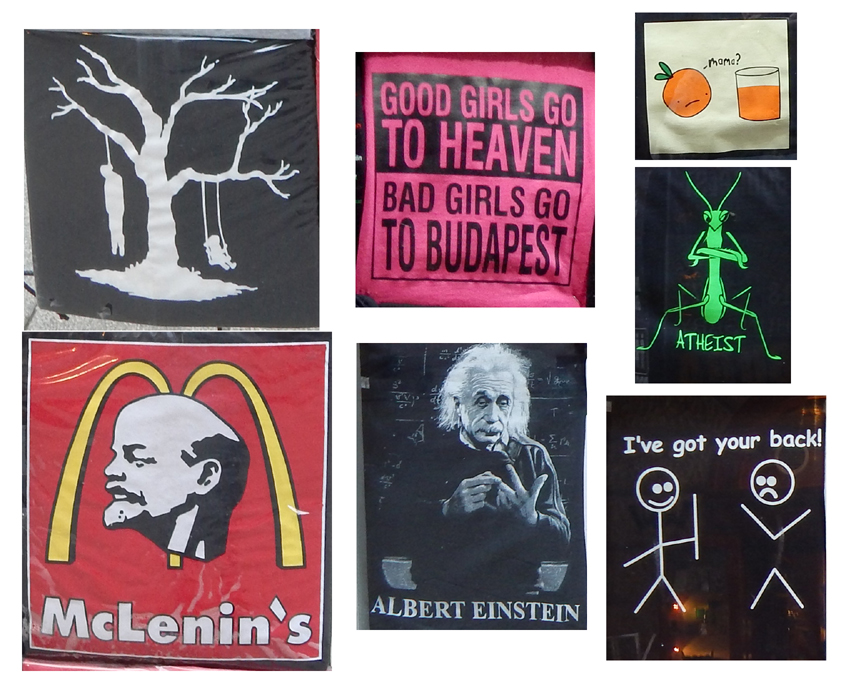
Budapest laughs at itself, even as it squeezes forints (money) out of the tourists for these irreverent T-shirts. Believe me, some were even more irreverent, but not ready for prime time.
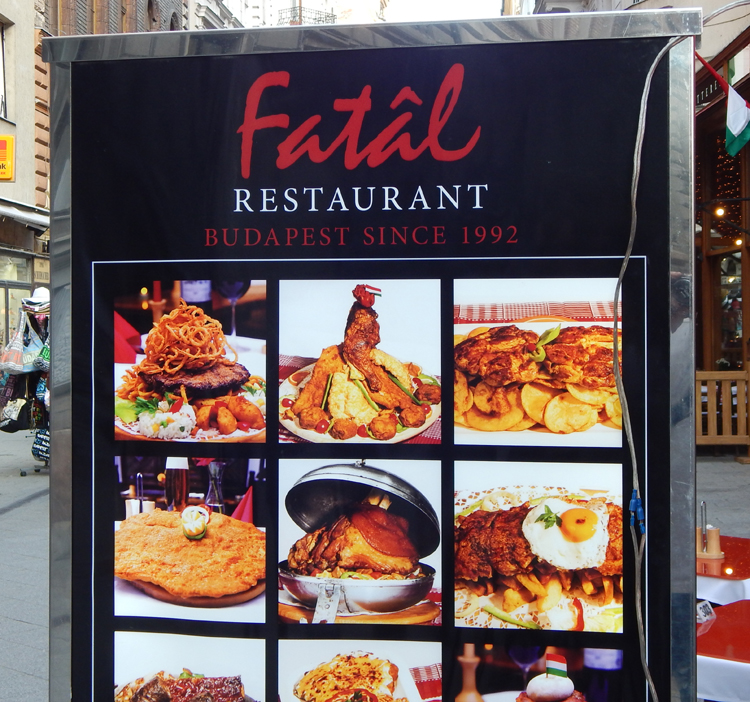
How many English-speaking tourists have taken a picture of the name of this restaurant, then joked back home that they survived a dinner there? Well, all I can say is that the dinner I had there was truly great. And yes, I'm writing this back at home, so I survived. (The meaning of "Fatál" in Hungarian is "Wooden Bowl", and the food here is served on wooden platters.)
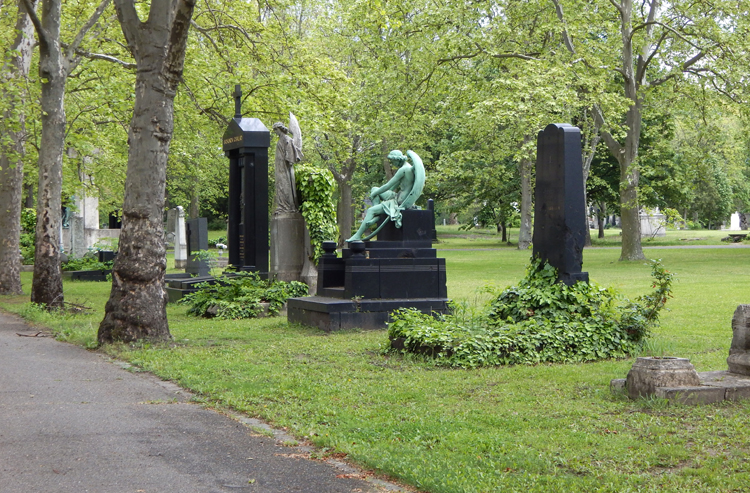
Budapest's Kerepesi Cemetery, like several others seen on my last two trips, is enormous, and the various sections are quite different from each other. Some are rows of graves close together, some are wide open fields with few plots, sometimes none at all - just meadows. Some sections are completely overgrown, like a sub-tropical jungle, so thick one couldn't even walk through them.
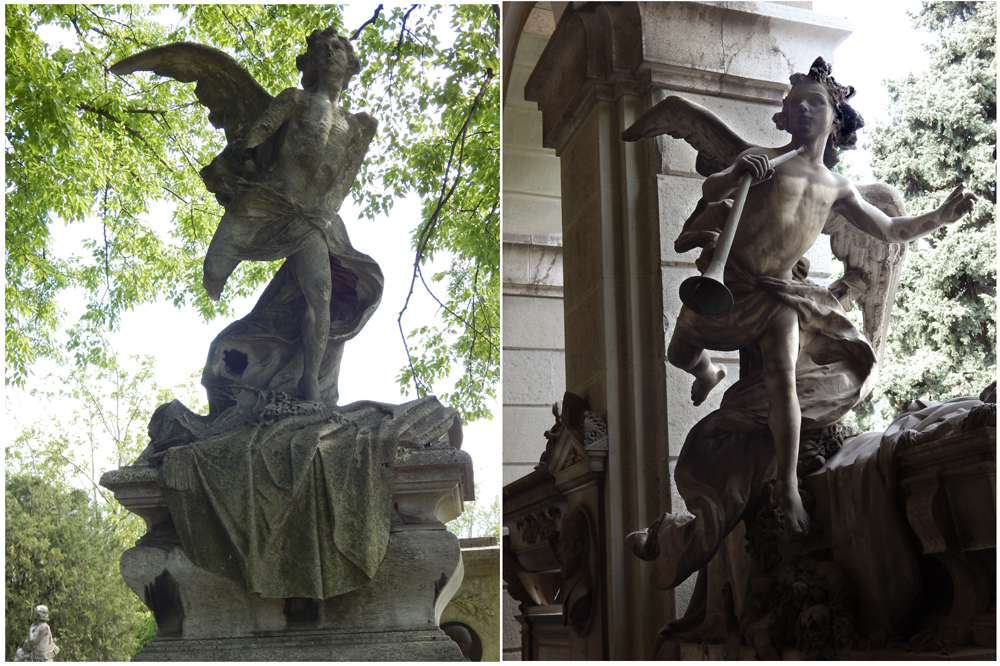
I was surprised to come upon this sadly disfigured statue (left), and realise that it closely resembles the monument for Carlo di G.B. Casella and family, sculpted by Giovanni Scanzi in 1877 at Staglieno in Genova. When I got home and compared them side-by-side, as shown here (Scanzi, 1877 on the right), the similarity was unmistakable. The monument at Kerepesi (left) has an inscription that marks this as the grave of Dr László Márton (1879-1942). Genovese sculptor Scanzi died in 1915. You do the math.
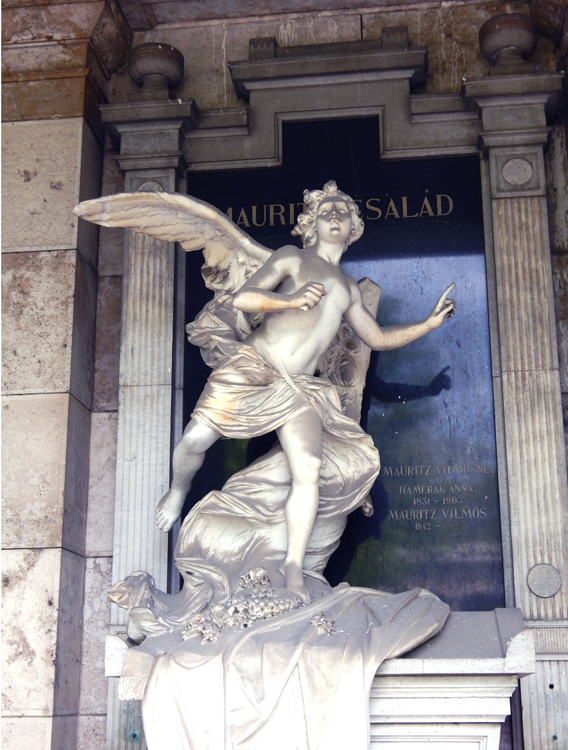
Then, I came upon this elegant monument, inside a portico and very well preserved (though dusty). Another comparison with Scanzi (see above) makes this also an example of . . . shall I say, imitation? This monument, for the tomb of Mauritz család (The Mauritz Family), is known to be the work of Hungarian sculptor Schmidt Gyula (1857-1923). Since he died just eight years after Scanzi, the math here is not so easy, though this tomb is dated around 1901, nearly 25 years after Casella's monument in Genova. Plagiarism? Imitation/Flattery? Who can say. Perhaps only a keen-eyed art historian.

This curious inscription looks like a mistake, but could be a form of shorthand, as when the year-range of 1921 to 1976 is written 1921-76, leaving off the redundant part of the second date. With only one digit redundant, though, it seems pointless to me to write 1847-910 instead of 1847-1910, especially when you have all that space.
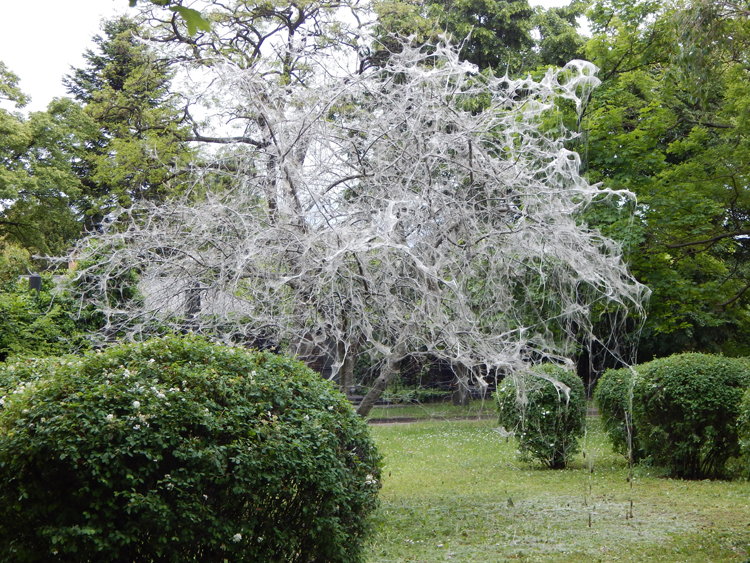
I wish I could tell you what kind of tree this is. I didn't see another one like it in the whole of Kerepesi Cemetery.
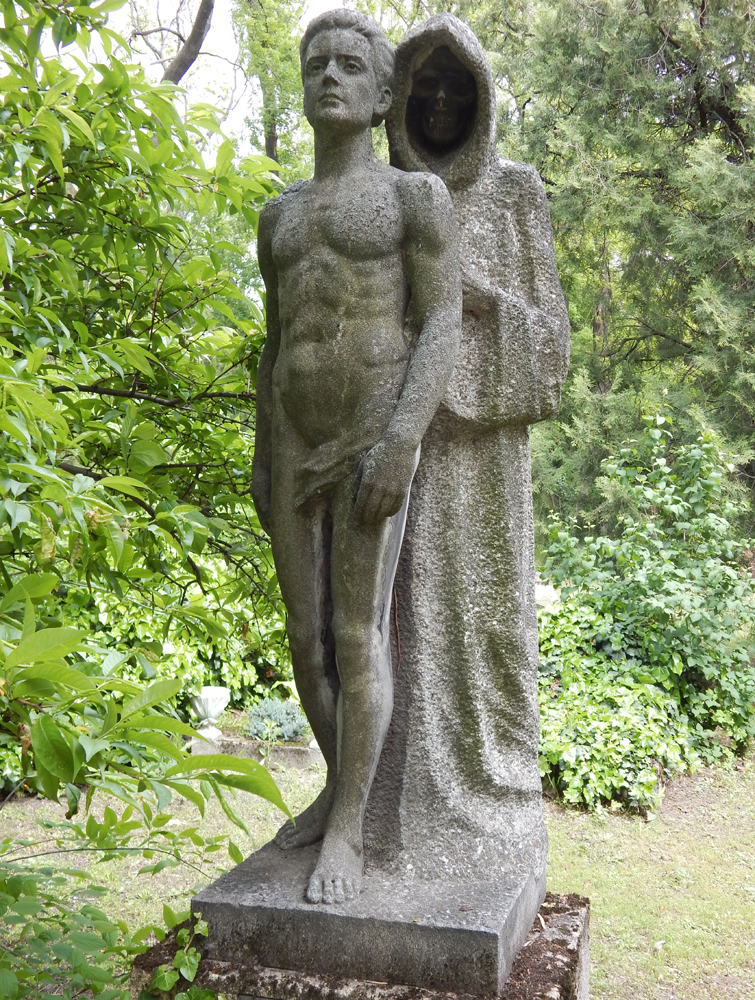
The symbolism, indeed the message, of this haunting sculpture is unmistakable. The grave is that of Dr Revay Bodog (died 1951), and his son, Revay Bodog öcsi (Junior), who died in 1925 at age 17, according to the inscription on the back. It seems obvious that the young man in the sculpture is the Junior Revay, with his gentle (?) escort close behind.
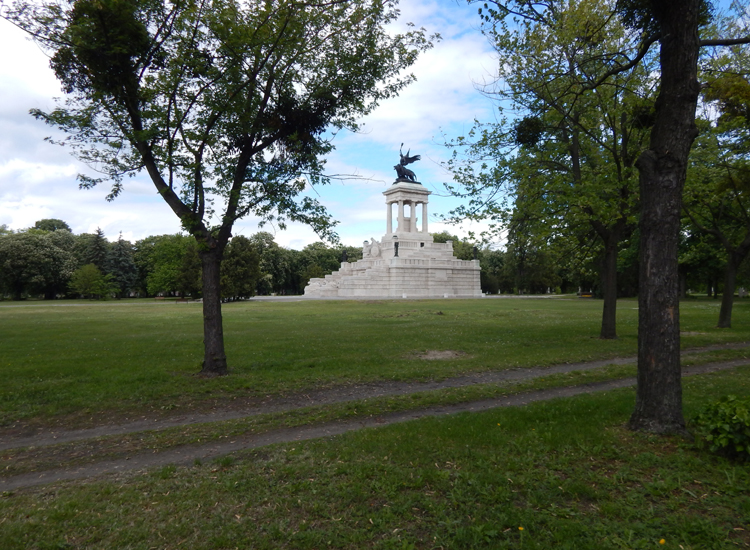
One of the wide open spaces in Kerepesi has this enormous mausoleum for Lajos Kossuth (1802-1894).

This Hungarian statesman was so important that there is even a bronze bust of him in the United States Capitol
(source: en.wikipedia.org/wiki/Lajos_Kossuth).

This is one of those surprises one invariably gets while walking around a new city. It's the Museum of Applied Arts, completed in 1896, and currently under renovation.
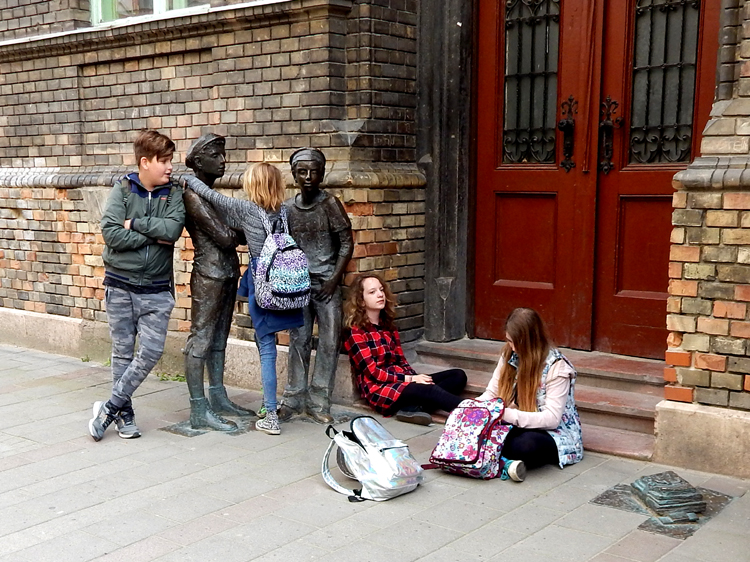
A Pál utcai fiúk [The Boys of Paul Street] is a 1906 novel by one of Hungary's most celebrated authors, Ferenc Molnár - or, as the Hungarians prefer, Molnár Ferenc. It's also a famous, but hard-to-find, 1969 film that made a big impression on me in my youth. When I learned that the novel had been commemorated in a street sculpture in BudaPest, I set out to find it. Some local kids beat me to it, obviously.
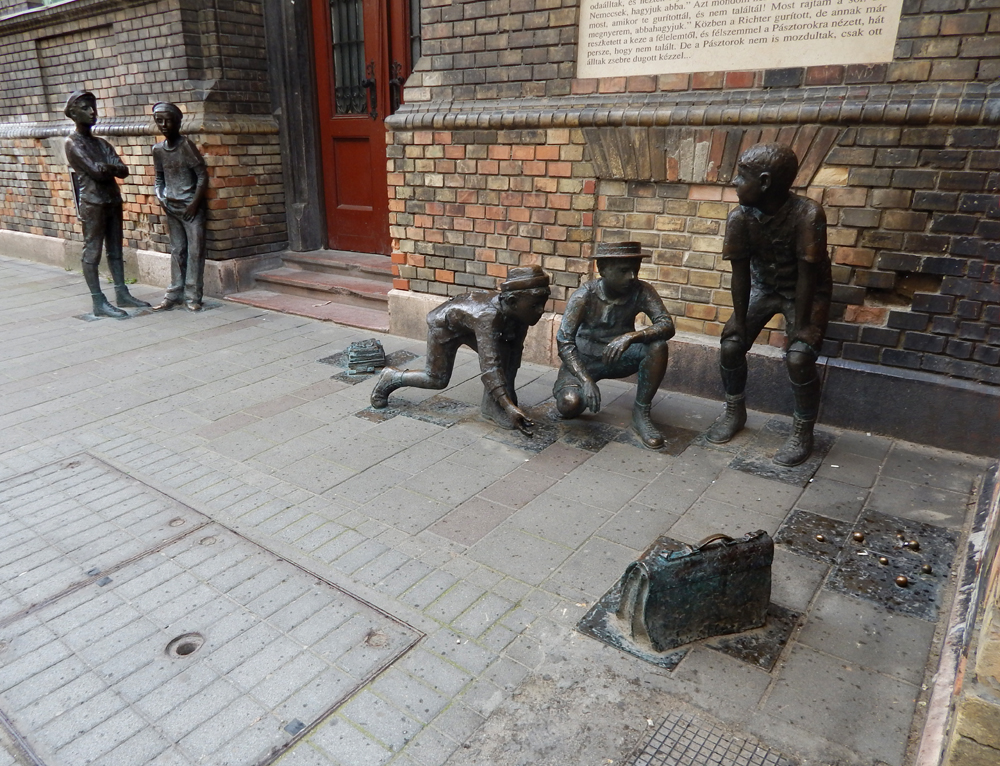
The live teens in the previous picture apparently were visiting the sculpture on some sort of field trip organised by an adult, likely their teacher. They took forever to clear off so that I could get a good picture of the whole unusual sculpture. (In the meantime, they weren't doing much other than repeatedly posing with the bronzes, occasionally molesting them - you know how kids are - and sitting around waiting for the light rain to let up.)
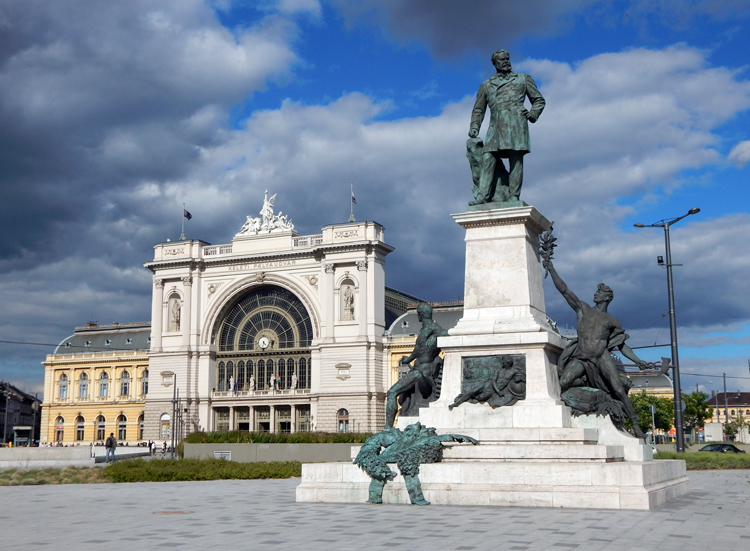
In front of Keleti pályaudvar (Keleti Railway Station) is the wide-open Baross Tér (Baross Square), with its centrepiece, the monument to Gábor Baross (1848-1892) by sculptor Antal Szécsi (1856-1904). The sculpture was placed there in 1898, while the railway station dates from 1884.
Praha (Prague), 11-13 May 2017

Sights like this are becoming relatively common in my travels. I've seen similar stereotypes recently in Firenze, and other places. I can only assume that people in other countries (other than America, that is) don't worry too much about political correctness. Maybe the horrors of two World Wars, still very much in their consciousness (for good reason), have kept them busy. This cut-out (not a statue) holding a real glass is outside of a wine bar in Old Town Prague.
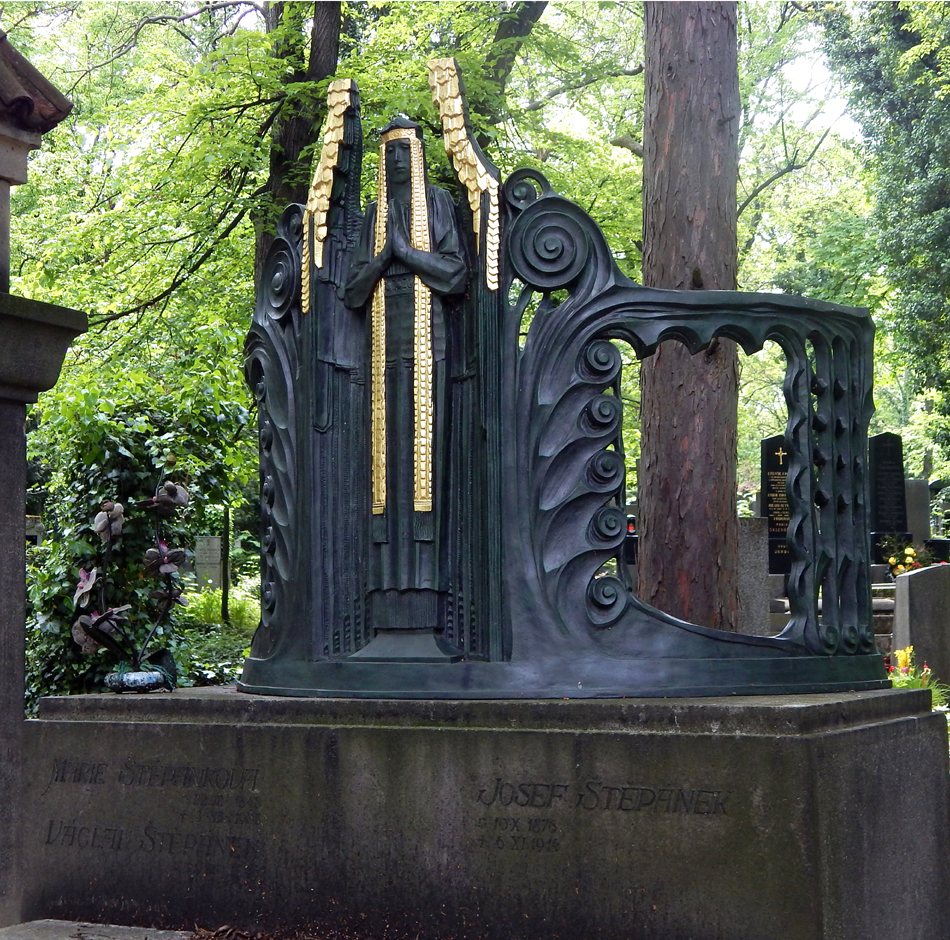
The cemetery in Prague didn't have much in the way of unconventional sculpture, with two exceptions. This monument to Marie Štĕpánkové is by the Czech sculptor Jan Kotĕra (1871-1923). Once again, this looks decidedly Art Deco to me, but according to the information plaque next to the grave, it was cast in metal in 1906. I suppose, then, it must be Art Nouveau.
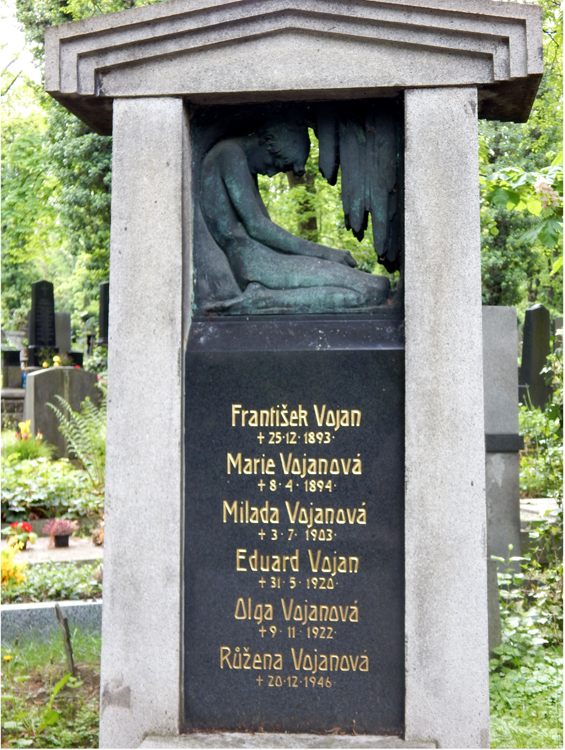
This unpretentious monument to the Vojan family dates from about 1920, after the death of its most famous member, the Czech actor Eduard Vojan.
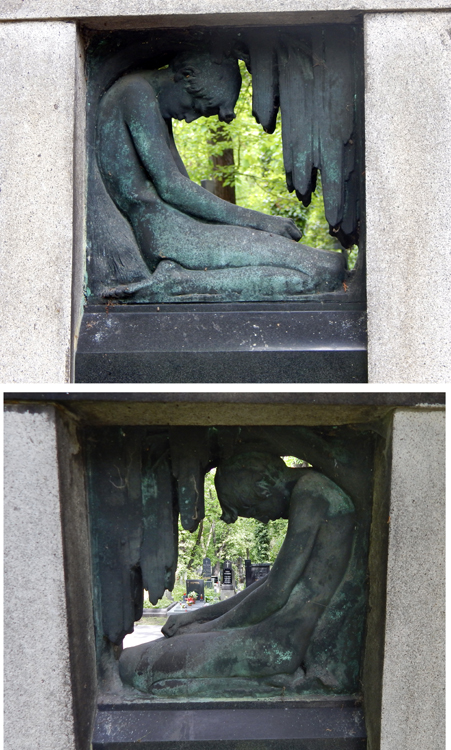
One can imagine the grieving figure is in a window, which you can see through from either side. It is quite effective and touching.
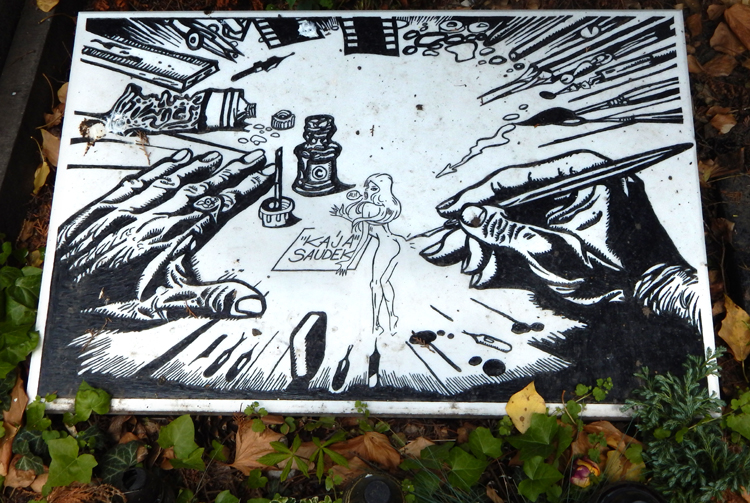
One of the oldest areas of Prague is the Vysehrad, the home of the mediæval Czech kings. In the stately churchyard there is a small, somber cemetery where many Czech dignitaries are buried - and in that churchyard is this gravestone for cartoonist and graphic artist Kája Saudek (1935-2015). It is so different from every other monument in this otherwise traditional cemetery that I had to look several times to realise that it was a grave marker, and not a prank.
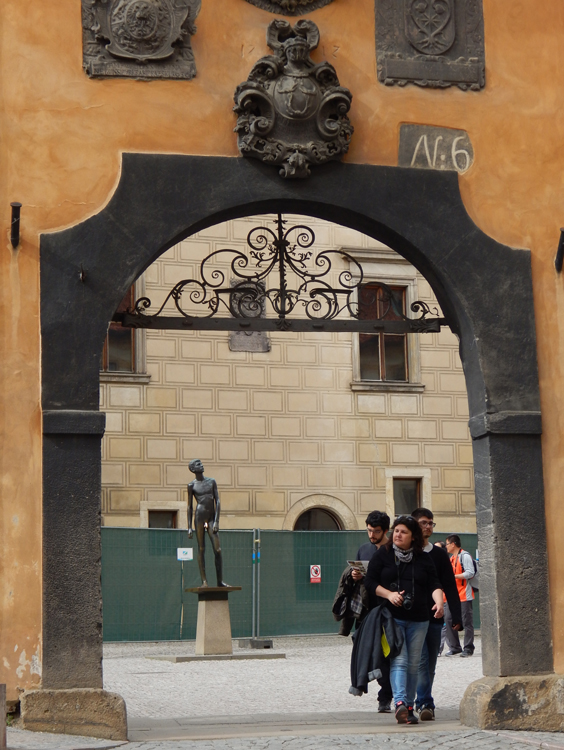
Speaking of pranks, this poor Youth [Mládi] by Miloš Zet, standing near the East gate of Prague Castle since 1963, is subject to daily, frequent humiliation.
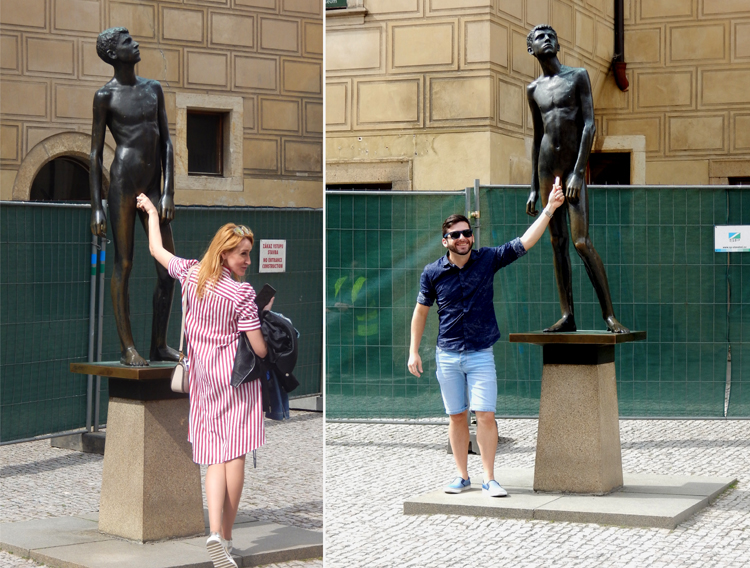
The poor guy is groped by tourists literally hundreds of times a day, while he seems to be trying his best to ignore them and retain his dignity. Many Web sites note this silly, but inevitable, tradition but make the predictable mistake of reporting that it is "female tourists" who molest the kid, when in truth, everyone takes a pull. Except me. I have respect, after all, for fine sculpture.
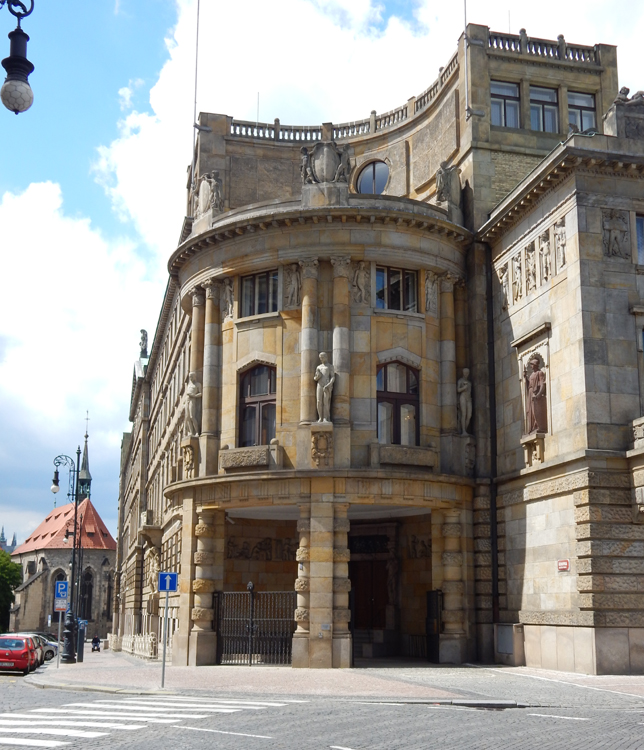
The Ministry of Industry and Trade of the Czech Republic sits on the banks of the Vitava (aka Moldau) River in Prague. The building was begun in 1928 and finished in 1934, and is decorated with many sculptures, both inside and out.
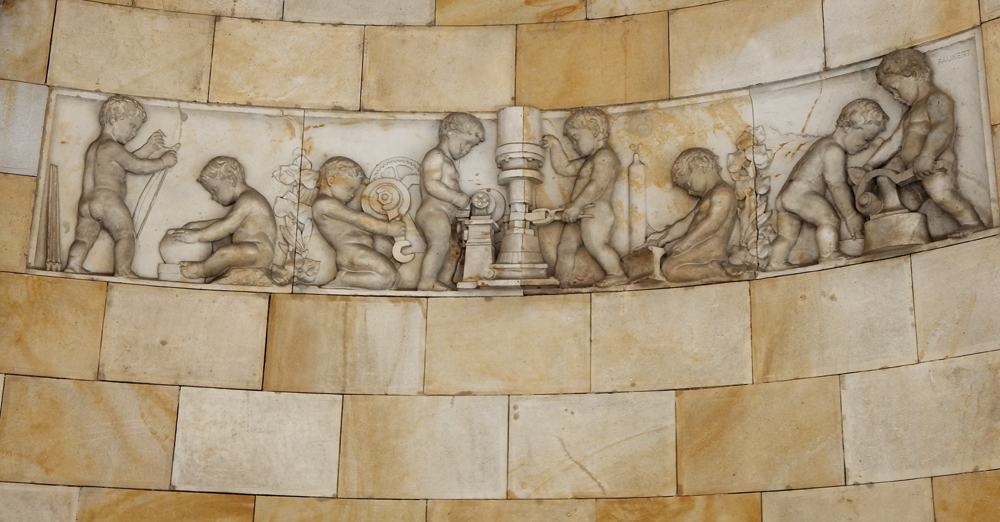
In the courtyard of the SouthEast portico (seen in the previous picture) this relief is found, depicting some of the industries and trades for which the building was built.
Hamburg, 14-16 May 2017

Of all the cemeteries I've visited so far, I'm sure Ohlsdorf is the largest. It took me two days to see about a quarter of it. This relatively recent mausoleum is not ornate, and has no external decoration, but reminds us of the bottom line: The Time is Coming.
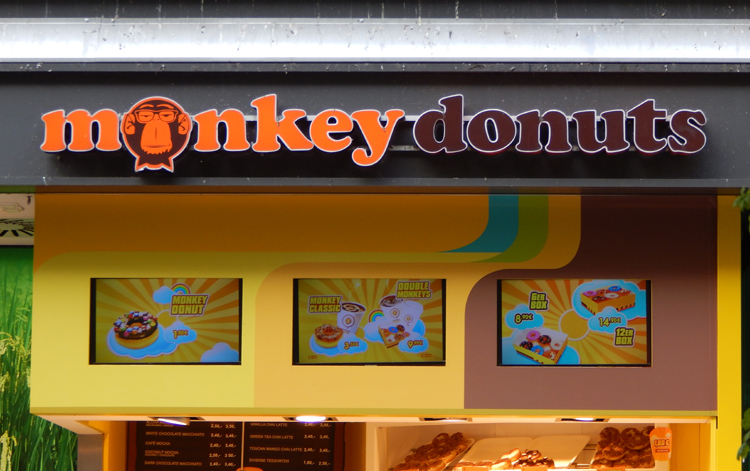
This store in Hamburg, like so many in all the countries I visited on this trip, has an English-language name. For me, I can't avoid reading this as a euphemism for something that I would not want to eat. Is this just a product of my perverted mental filters (or the lack of them)?
in transit by train, 17 May 2017
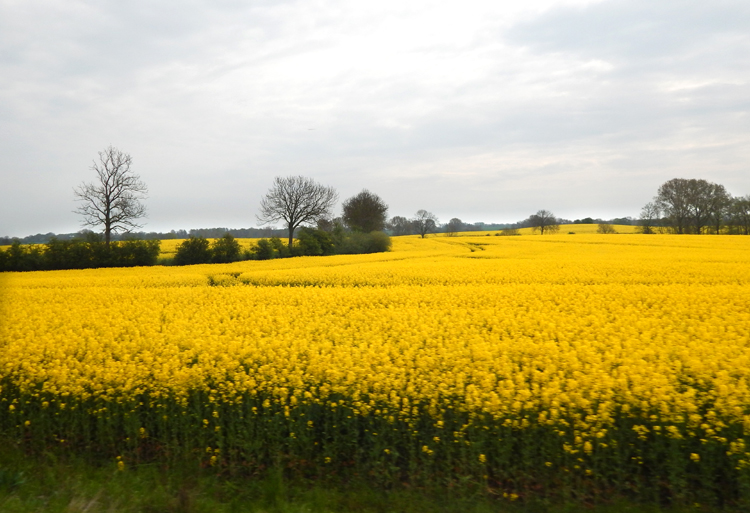
Rapeseed (Brassica Napus), also known as oilseed rape or rappi, is a bright-yellow flowering member of the mustard or cabbage family and is used to make canola oil and animal feed. There must be a huge market, as it is all over the place in Northern Germany and Denmark. The effect of a sunlit rapeseed field is truly startling.
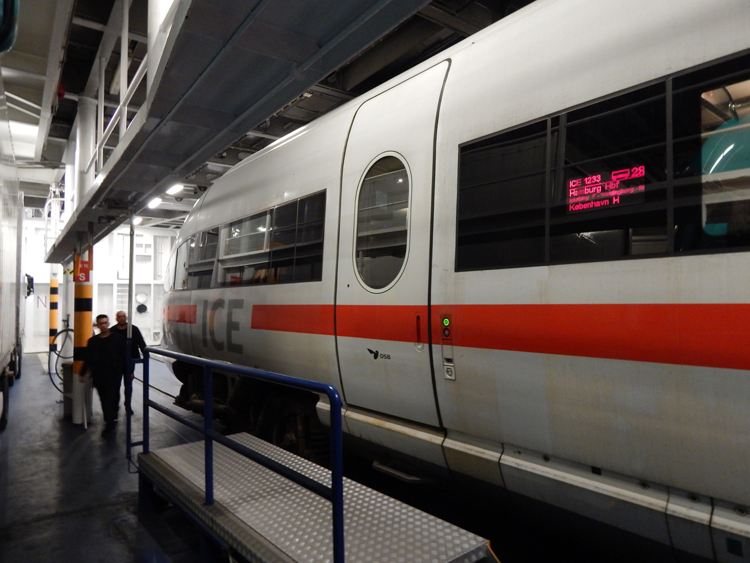
For the second time in my travels, I was on a journey that went across water where there was no bridge - in this case, Germany to Denmark - and to accomplish this, they just ran the whole train onto an enormous ferry, then off again on the other side. Once you actually see this happen, it seems so obvious, but I would guess the first time it was ever proposed there was at least a bit of laughter among the engineers.
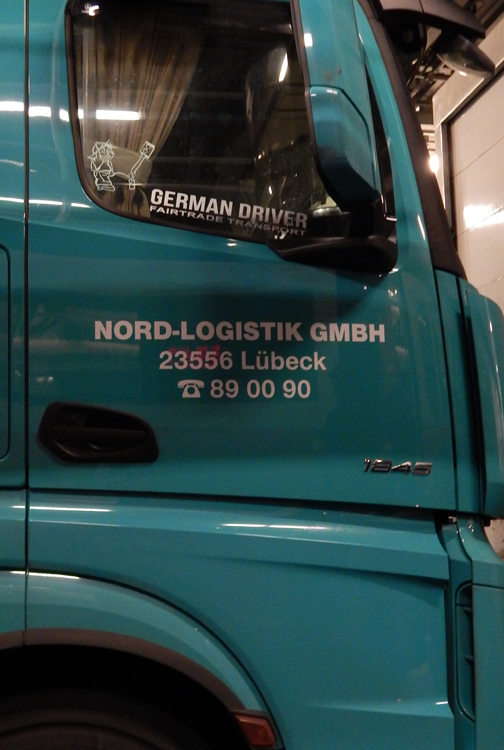
On the ferry, beside the train and automobiles, was this truck, with the curious sign on the window, "German Driver". Does this get him (or her) perks at toll booths? Or maybe it's a caution to other drivers to be especially courteous, like those stupid "Baby on Board" placards seen in America. Or maybe it's just their version of a warning: "Look Out!"
Denmark - Hvalsø, Roskilde, København, 17-20 May 2017
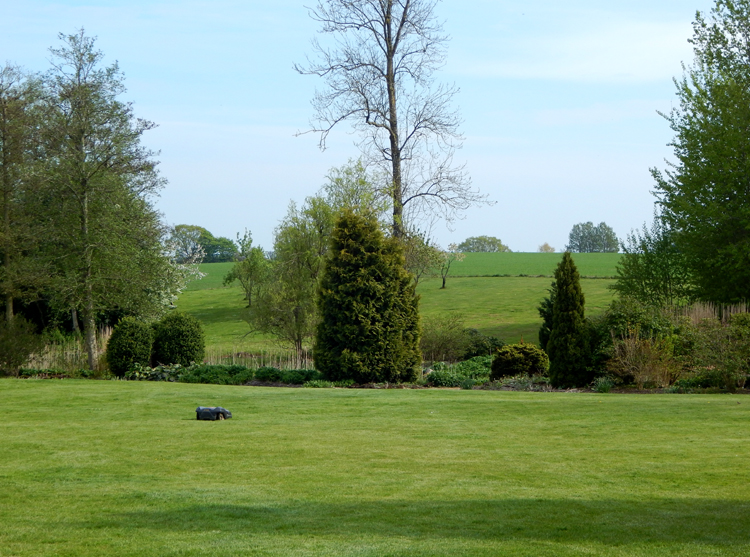
Because of a mix-up in my reservation, I had an extra night to "cover" between Hamburg and my Denmark hotel, so I booked a night in a rural town called Hvalsø, at a hotel with the quintessential Scandinavian name of Sonnerupgaard Gods, originally a large, wealthy farm built in the 1850s. This is the view from the back of the main building. That small, black machine in the center left is a Husqvarna robot lawn-mower, silently doing the work of ten village kids at a fraction of the cost.
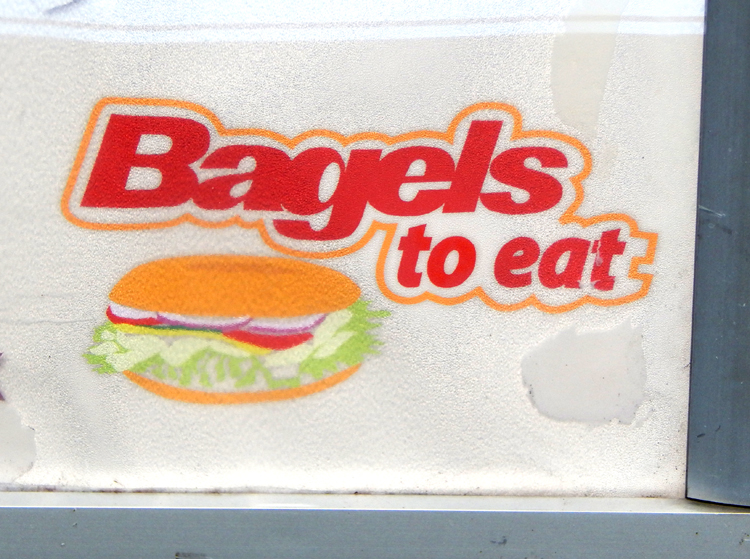
Prices of hotel rooms in København were too steep - the Asian tourists probably had already booked the more reasonable ones - so I opted for a suburban town called Roskilde, only about 12 minutes by train into København and a bit more reasonably-priced in my view. This food cart was in the town centre. I looked, but could not find bagels being sold for other purposes, such as "Bagels to Contemplate", or maybe "Bagels-as-Frisbees".

København was not on my original itinerary, but as I got closer to Hamburg, I decided that I would add it on, since I was so close and the great Glyptotek museum was waiting there, as was this thirsty lion out front of the historic museum.
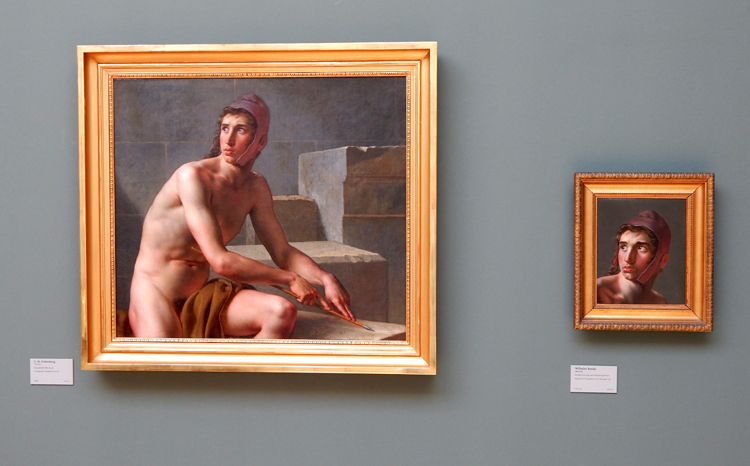
Inside the Glyptotek, among many treasures and curiosities, are these two renderings, hanging side by side, of virtually identical subjects - the one a full figure, the other just a head and helmet. What's remarkable about these paintings is that they were painted by different artists: according to those little cards under each, the one on the left is Young Man Sharpening His Arrow (1812) by C.W. Eckersberg (1783-1853), and the one on the right is Young Man with a Phrygian Cap (no date listed) by Wilhelm Bendz (1804-1832).
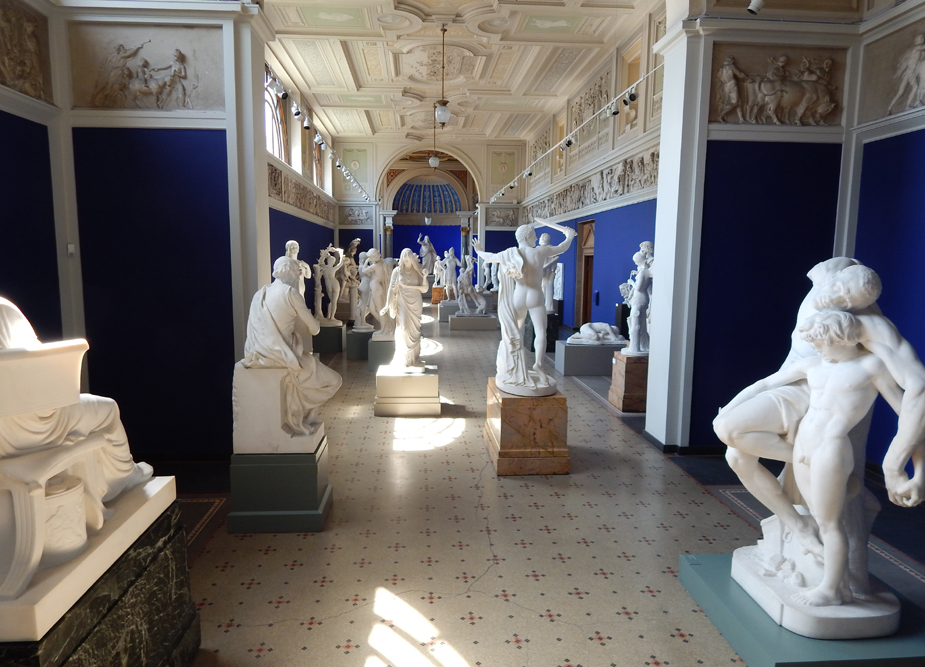
The Glyptotek probably has more sculpture per square foot than any other museum I've yet seen. And this is only one of several crowded rooms.